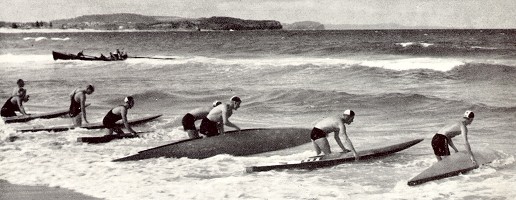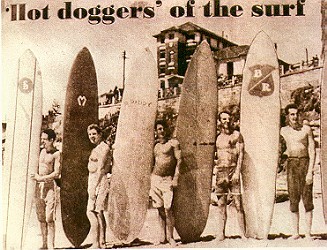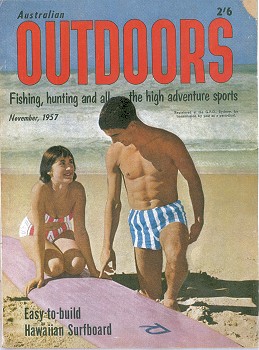surfresearch.com.au
 |
surfresearch.com.au
history
: 1956 international surf carnivals
|
the international surf carnivals,
1956.
torquay, victoria, maroubra and collaroy,
nsw.
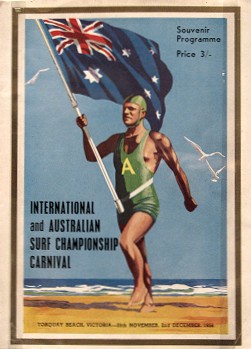
"International
and
Australian Surf Championship Carnival,
Souvenir
Programme Price 3/-
Toquay
Beach, Victoria. 25th November 2nd December 1956. "
Photograph of displayed item.
Between the Flags Exhibition, ANMM, Sydney. 22 April 2007.
Introduction
In November 1956,
Australian surfers had widespread exposure of to the modern
fibre glassed surfboard, ridden by visiting Californian and
Hawaiian lifesavers.
Two teams,
representing the U.S.A. and the Territory of Hawaii, were
invited to compete at international surf lifesaving carnivals
held in conjunction with the 1956 Olympic Games.
Most
commentators, often quoting Greg Noll : Da Bull – Life Over
The Edge (1989), focus on the International Carnival at
Torquay and emphasize the occasion as an almost incidental
development with dramatic consequences.
During
one
event, we had noticed a little point break off to the
side, off a rocky point.
I don't
remember the name of the place.
After the
paddling events were over, we grabbed our boards and
paddled out to the break.
There had
been thousands of people watching the paddling events from
shore, and they had started leaving.
Ampol Oil
was covering all the paddling events, and decided to stay
and take fIlms of us surfing.
Word got
around in the parking lot as people were leaving, "The
Yanks are surfing, you ought to see the Yanks." - Noll (1989),
Page 71.
Although context
implies this happened at Torquay, Noll's recollections probably
relate events at Avalon (Sydney) on the 18th November, which
were possibly not filmed.
Rather than an
incidental pollination, this paper notes that the arrival of the
Malibu board was clearly announced by the Australian press to
anyone with an interest in board riding.
The account of
the events and repercussions, has six identifiable
perspectives.
Surf Life
Saving Australia (SLSA)
Association
with the Olympic Games was seen as elevating Australian surf
life saving competition sport to international prominence.
Unfortunately,
although exposure exceeded any previous event, the sport
failed in its bid to be an official Olympic demonstration
sport and the location (not in the sport's heartland of
Sydney, and then some 60 miles outside of central Melbourne)
was less than ideal.
Competitively,
results were mixed, with some visiting teams performing well.
Since the teams
from the British Commonwealth were largely formed under the
auspices of the Australian movement, this was possibly less
than flattering.
Despite the
superior performance of the the U.S.A. and Hawaiian teams'
equipment, Australian lifesavers apparently retained their
preference for the hollow timber board into the 1960s and it
was not until the 1990s that the belt and reel was replaced by
the Torpedo Buoy.
For some clubs,
the introduction of the Malibu board caused significant
disruption.
This was the
third organized association with international surfing by the
Australian lifesaving movement.
Unlike the 1956
carnival, the impact of the earlier occasions (Duke
Kahanamoku's surfing demonstrations in 1914-1915 and the large
representative team sent to the 1939 -1940 Pan Pacific Games
in Honolulu) were significantly truncated by the subsequent
outbreak of world wars.
The
U.S.A. - Hawaiian Teams
For the
Californian and Hawaiian surfers, the tour was an
opportunity to test their skills and equipment in
unfamiliar conditions.
Competitively,
they performed to a high standard and placed in many
events.
The
success of their equipment was significant, and
proved the fibre glassed board would be superior in
all future surfing locations.
Furthermore,
it began an association with Australian
manufacturers that was to accelerate in the 1960s
with the replacement of balsa wood with the foam
blank.
In
the case of Greg Noll, it opened another market for
his early surf films.
Impressed
with the organization of the carnivals, members of
the Californian team adopted many facets of the
Australian surf lifesaving movement in the
development of their own lifeguard services and
there is evidence that the surf ski was of interest
to some Hawaiian surfers.
Image
right : "Plate 33. Dick Patterson with
one-man Australian surf-ski, Waikiki Beach.
By
O.B. Patterson, Honolulu, Hawaii".
Image
and caption Patterson
(1960) Plate 33.
Note
the ski bears the Ampol script on the nose.
Ampol
Petroleum was the major sponsor of the 1956
international carnivals.
On
the same page, Patterson also includes another
photograph (not reproduced) ..
"Plate
32. Neil Ifverson with two-man Australian
surf-ski, Waikiki Beach.
By
O.B. Patterson, Honolulu, Hawaii".
.
|
 |
Note that in
the 1940s, an earlier model Australian surf ski, acquired as a
gift at the 1939-1940 Pan Pacific Games, was ridden with
remarkable skill (illustrated by film of the period) at
Waikiki by Duke Kahanamoku,
The
historian for the County of Los Angles Lifeguard Division
offers this assessment ...
"This
singular event is recognized as the most influential surf
lifesaving carnival ever held. The international surf
lifesaving community was introduced to the rescue can,
lightweight paddleboards, fiberglass surf boards, relays
and iron man competition, as well as to the overall
capabilities of the modern, well trained, professional
lifeguard."
http://www.lacofd.org/Lifeguards/WhoIsHistoryByDecade.asp
On a personal
level, the tour probably had a variety of attractions beside
the desire to compete at an international level.
The experience
of travel, expanded social relations and potential romance are
other possibilities.
In the case of
Greg Noll, any expectation of potential romance appears to
have been realised ...
"One
night ... no less than five different ladies decided to
bestow their warm,
Australian
hospitality
on this poor Ol' Yank. To this day, I have never
received
such a warm welcome, not even in my own native land of
California."
Australian
Boardriders
The impact of
exposure to state of the art boards ridden by elite boardriders
on Australian boardriders was immediate.
The new
techniques were intensively studied, particularly with access to
film of the performance, and replicated.
Experienced
hollow board riders quickly adopted the new design and there was
an explosion in the number of juvenile riders.
By 1961,
Australian surfers, notably big wave rider Bob Pike, made an
impression in winter surf in Hawaii - considered the benchmark
of high performance.
In 1962-1963,
Bernard 'Midget' Farrelly of Freshwater won the prestigious
Makaha Contest in Hawaii.
Farrelly would be
at the international forefront of high performance surfing for
the next ten years.
Boardriders
from Other Nations
The impact of
boardriders from other competing countries was also
significant, principally in New Zealand and South Africa.
With a
traditional relationship with the Australian movement, a more
primitive manufacturing base and limited access to materials,
both countries initially adopted the Okinuee - a hollow timber
adaptation of the malibu design by Australian manufacturers.
Australian
Manufacturers
While
unfamiliarity with the new materials and new production
techniques would be a major difficulty for Australian board
builders, these developments were initially stalled by the
lack of suitable balsa wood.
Experienced
hollow wood builders were able to closely replicate the
design, often called an Okinuee, by including a thick
timber rail that could be shaped to a rounded edge.
The increasing
demand for boards moved the current Sydney builders from their
backyards (often in the Eastern suburbs) to industrial
factories, ideally located at Brookvale, adjacent to the
multitude of surfing locations between Manly and Palm Beach.
The tour also
initiated a correspondence on construction and design between
American and Australian manufacturers that accelerated with
the introduction of polyester foam blanks.
The
Australian Press
This study is
confined to the domestic Australian press and does not attempt
to locate and assess reports in international newspapers.
Although the
international carnival was a popular item, it had to compete
against the major journalistic focus on official Olympic
events, largely in metropolitan Melbourne.
The interest in
surf lifesaving was greatest in beach side Sydney, the home of
the movement, which probably accounts for the expansive
coverage by that city's press.
Press reports
provide a reliable chronology and generally appear to be
accurate in crowd sizes, weather conditions, competition
results and participants (with some misspellings).
Board
descriptions vary in their detail, occasionally
identifiable as paddle boards but mostly the boards are
Malibus.
The Malibu's
large fin and it's significance are rarely reported.
The balsawood
blank and the coating with fibreglass is regularly noted.
Other possible
features of interest, such as variation in length, template
shape or decor, are mostly absent.
There is one
report of construction using redwood stringers.
It is possible
that the reporters interviewed only a small number of team
members, or viewed their boards, at the time and then applied
these details to all the boards.
The Malibu Board - A Design or a Technology?
The development
of the Malibu board (somewhere between 1946 and 1950), despite
it's importance, is historically unclear and
(fortunately) outside the scope of this paper.
Several surfers
are identified as contributing, in varying degrees, to the
design.
These include
Joe Quigg, Matt Kivlin, Dave Rochen, and Dale Velzy in
California.
Most
commentators regard the role of Bob Simmons as pivotal,
however a distinct lack of printed resources and his early
death by drowning (26th September 1954), complicate a fully
accurate assessment of Simmons' contribution.
In Hawaii,
developments appear to have lagged only marginally behind
California, probably pioneered by George Downing.
The only book
that can be said to adequately examine this period is Paul
Holmes' 2006 publication, Dale Velzy is Hawk, Chapters
4 to 8.
Regardless of
various individual design features or dimensions of the early
models, the two elemental developments were the application of
a fibreglassed skin on to a hand shaped blank and a large fin.
Fibreglass
technology produced a board of significant strength, a huge
reduction in weight and the ability to sculpt an infinite
variety of shapes.
The use of
fibreglass was not limited to the wave riding Malibu board.
US and Hawaiian
surfers had a long tradition in surfboard racing and rescue,
and the new technology was also applied to these craft. See Blake
(1961) Pages 27 to 30 (unspecified in the text).
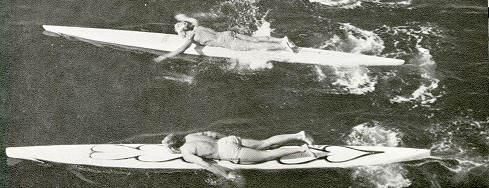
"PADDLE
BOARD
RACING
Photo: Drummond
As the
experts strive for honors, these streamlined hollow
paddleboards,* leap ahead at a speed of about 7 miles per
hour. Obviously a good lifeguard water rescue device, as
well as a healthy sport. Paddleboard racing is popular in
Hawaii, California, Australia, South America. These boards
measure from 18 to 22 feet in length, and are from 151/2
inches to 18 inches wide, maximum. They are 4 to 6 inches
deep and are constructed out of a hollowed-out Balsa wood
hull, covered with fiberglas. They weigh from 20 to 30
pounds and are all custom built.
Competitors
(from bottom) :1-Bright, 2-Zahn, (and cropped)
3-Alter, 4-Hogan.
*Invented
by Blake
1926." Blake
(1961) Page 28
It must be noted that examples of
these advanced race and rescue boards were brought to Australia
by the US and Hawaiian teams as well as a model of the Torpedo
Buoy, previously developed by Walter V. H Biddell at the Bronte
Surf Life Saving Club, 1902-1906.
Greg Noll, in a
brief comment, notes ...
"We
had come to race paddleboards. As it turned out, our
surfboards became the real attraction."
Noll's life
guarding and paddleboard activities before 1956 are recalled in
the ninth chapter of his autobiography, "Of Paddlers and
Life Guards", pages 62 to 65.
Apparently
these craft were overlooked at the time by the Australian surf
life saving movement, and by most subsequent commentators.
Furthermore,
somewhere in this period the application of paraffin wax to
the deck of the board became standard practice, greatly
increasing the traction of the rider.
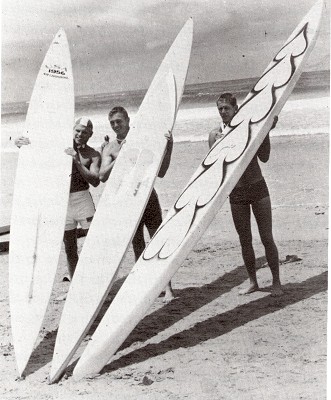 |
Left
:
Tom
Zahn, Greg Noll and Mike Bright
with
Fibreglass and Balsawood Paddleboards,
Australia,
1956.
Galton, page 112.
The
photograph (Torquay, by implication) is credited
"Among
the first of the malibus - around 1956".
Also
printed in Wells
(1982) Page 152.
Credited
as
"Soon
to become a relic of the past
-
longboards in 1956.
Manly
Library".
Galton
and Wells are in agreement on the date.
A
similar, but not identical, photograph is printed in
Bloomfield
(1959) facing page 161, with the credit
"USA
and Hawaiian competitors with their
boards
at the Olympic International Surf Carnival,
Torquay Beach, Victoria, 1956.
Fred
Lang Studios."
|
Note that Zahn's
board features the text "U.S.A. 1956 Melbourne" on the
nose, Noll's board has deep kneel paddling wells and Bright has
the same board as shown in Blake
(1961) Page 28, above.
Bloomfield’s
credit to “Fred Lang Studios” and Wells' credit to "Manly
Library" possibly indicate the photograph was taken on the
northern beaches.
Australian Surfboards, circa
1950.
By the 1950s, the
surf life saving movement effectively dominated surfboard riding
activity.
To a significant
extent this was, in a period of limited automobile ownership,
simply a function of the need to store these large and heavy
craft adjacent to the beach.
Some club members
viewed patrol and other club duties as "rent" for their week-end
beach side accommodation and access the the club's range of
surfcraft.
With an
emphasis on race and/or rescue performance, the lighter hollow
board and the similarly constructed surf ski were the
preferred craft.
Although some
solid wood boards were still available at some clubs, these
were usually for recreational or training activities
only.
Such was the
status of Duke Kahanamoku's famous Freshwater
board of 1914 ...
"During
the
early 1950's the board was stored amongst the current
boards, given no special
prominence
and
on occasion was used by Club members, including myself."
- Joe Larkin, noted in a phone conversation,
February 2004.
In the
mid-1940s the popularity of recreational board riding led to
an attempt to promote the activity independent of the formal
SLSC structure.
This challenge
was quickly recognized and countered ...
"The
senior longboard became a national event in 1946 (102),
but the SLSAA had been pricked in 1945 by the formation of
the Surf Board Association of Australia which it stated
was:
''attempting
to
encroach upon the preserves of constituted authority
guarding
surf
bathers by running a pseudo 'Surf Board Championship of
Australia' (104)''
It seems
that the SLSAA did not want this new 'hedonistic'
Association, which also had women members, involved in its
competition or competing for the social space which was
occupied by disciplined surf life saving clubs on Australian
beaches. The Board Association was refused affiliation by
the SLSAA on the grounds it was not a life saving club, and
members of life saving clubs were prohibited from
participating in surf events organized by an
unaffiliated association. The advent of the board
Association seemed to precipitate the SLSAA's formation of a
Surf Board and Ski Section, and formulation of appropriate
rules for use of boards and skis in its affiliated clubs, as
a means of rescues and in carnivals (105)."
Australian Exposure to the Malibu Board -
1950-1956.
In 1950-1951, the
first recorded fibreglass and balsa wood surfboard in Australia
accompanied Hollywood actor and Malibu Point surfer, Peter
Lawford.
He was in
Australia in 1950 to film Kangaroo.
Released in June
1952, it was the first Technicolor movie filmed on-location in
Australia
Filming was based
at Pagewood Studios, Sydney, and locations included South
Australia, New South Wales and
Queensland.
See http://www.us.imdb.com/title/tt0044788/maindetails
The board was
identified by Albie Thoms (2000) as a finless board by Dave
Rochlen Surfboards, stored at Bondi for most of Lawford's stay
and ridden by locals Jack 'Bluey' Mayes, Ray Young and Aub
Laidlaw.
"A
Rochlen skegless board had been brought to Sydney by the
American actor, Peter Lawford, when he arrived in Sydney
in November 1950 to work on the Twentieth Century Fox
production, Kangaroo (1952), which was shot in the
Flinders Ranges in South Australia.
While
filming, he left the board at the Bondi surf club, where
it was ridden by the local beach inspectors, Jack 'Bluey'
Mayes, Ray Young and Aub Laidlaw, though it didn't seem to
impress them, with Laidlaw later achieving notoriety for
banning both bikini-wearers and boardriders from Bondi
Beach."
Thoms
(2000) page 63.
Contrast this
with Greg McDonagh's conflicting, and incorrectly dated,
report:
"In
1954,
actor Peter Lawford, filming in Australia, aroused
widespread
interest
among surfers with a board called a Malibu...
" Pollard
(1964) page 56.
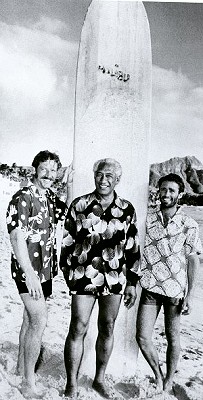
|
Duke Kahanamoku with (actors)
Richard Boone and Peter Lawford
and
a board called 'Malibu',
Waikiki,
1950.
Printed in Severson
(1967) page 35) and captioned:
Richard
Boone, Duke and Peter Lawford
pose on
the beach at Waikiki, in 1947.
Lawford had one of those new
"Malibu" boards
made of balsa and fiber glass.
Duke tried it but preferred his own
16 footer.
Severson's
date of 1947 is incorrect.
Subsequently
reprinted in
Brown
(2006) page 143.
In
Sydney, Boone and Lawford were photographed (right0
wearing the same Hawaiian shirts.
The Australian Women's Weekly
Saturday 25 November 1950, page 17.
|
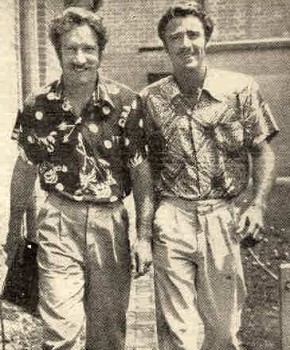
|
The
board
was possibly the work of Bob Simmons, Joe Quigg, or Dave Rochlen.
Dave Rochlen was
the favoured builder among Hollywood surfers, noted for the
outstanding quality of the colour and decor design.
See Matt Kilvin on Joe
Quigg and Dave Rochlen in Longboard, Volume No. pages ?
PETER LAWFORD
From Levy, Shawn: Rat Pack
Confidential, Fourth Estate
Limited, London, 1998.
Peter Lawford was born in
England in September 1923, his conception resulting from the then
Mrs. Mary Aylen's adulterous liaison with her husband's
commanding officer, Sydney Lawford.
- pages 58-61.
The scandal surrounding Peter's
birth drove the Lawfords from the country; they were to live in
France, India, the South Pacific, Hawaii, Florida, and
California for the rest of their days, maintaining, frequently
enough, a sufficiently high standard of living to seem gay
globe-trotters, but, in reality, terrified to return home to the
hisses of English scandal-mongers.
- page 61
There was, however, another social
group with which Peter mingled and to whom he showed an.
especially generous and loyal side of his nature.
Having been introduced to surfing as
a young boy in Hawaii, Peter had a genuine love for beach life,
and he spent all the time he could at the shore, catching waves,
playing volleyball, and steeping himself in the lingo and
rituals of beach bums- a cultish society whose vocabulary and
attitudes would later be borrowed, in a fashion, by the Rat
Pack.
May hated the ne'er-do-well manner
of this crowd -which, of course, attracted her son to it even
more.
Moreover, Peter relished mixing his surfing and acting cronies,
watching the cultures clash with sophomoric delight.
- page 64
Peter Lawford died on the 14 December
1984 and following four years of family disputes, his ashes were
scattered in the Pacific ocean.
- page 301.
|
Peter Lawford aged 11 at Waikiki,
1934.
Peter Lawford, later to become a
widely known actor, sits on the oceanside
terrace
with his parents, Gen. and Mrs. Sydney Lawford, in
November 1934.
Lawford
would go on to a long acting career and a marriage
into the Kennedy clan. Hawaiian
Archives.
Cohen, Stan:
The
Pink Palace - The Royal Hawaiian Hotel.
Pictorial
Histories
Publishing Company, Montana,1986,
page 89.
|
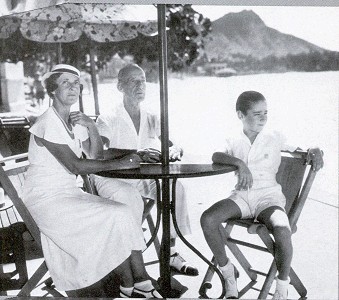 |
|
Right:
Prince of tides: Peter
prone on a longboard in Hawaii
with the great surf
champ, Duke Kahanamoku.
(Archive Photos)
- Levy: Rat Pack
Confidential
London (1998), between pages
184 and 185.
The photograph was probably
taken at the same time as the photograph of Lawford with
Duke and Richard Boone, above.
Note that Lawford's board is
significantly shorter than Duke's massive board.
|
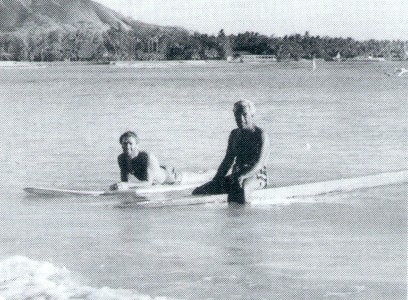 |
At
Waikiki,
Lawford and Duke Kahanamoku swapped boards, the occasion
recalled in the early 1960s by Duke in an
interview with Surfer (Volume 6, Number 1), and reprinted
in:
Severson, John
(editor): Great Surfing
Doubleday and
Company, New York, 1967, pages 29 to 33, with a selection of Duke
photographs on pages 33 to 37.
Surfer (probably John Severson):
Duke, these foam boards that are ridden today are quite a
bit different from the big, heavy solid wood boards of your
day.
What do you
think of that?
Duke:
This board of mine, which I have today, is sixteen feet
long, twenty-two inches wide, and three and a half inches
thick.
It's solid redwood.
You speak about these light boards.
The first (light) board I tackled was Peter
Lawford's board.
When Peter first came to Honolulu, he
brought this board, and we swapped boards right out there at
Canoe's surf.
I took one wave.
It was kinda tricky, as you know.
I thought, "Well, I'd better stick to my own
solid board, which is steadier and easier to manage."
I said to Peter, "You better give me my
board and you take your board back."
And that's the swap and that's the last I
ever rode on one of these tricky boards they have.
But these kids are really expert on handling
these boards.
They spin around and then come right up and
hit you in the head.
And then they put the brakes on and that
board comes up and then goes backwards, and (laughing) I
don't know where else it goes.
- Severson: Great Surfing (1967), page 32.
The photograph of Duke with Boone and
Lawford printed in Great Surfing (page 35) is captioned
(incorrectly):
Richard Boone, Duke and Peter Lawford pose on the beach at
Waikiki, in 1947.
In 2007, Sean Brawley wrote
at length about Lawford's visit to Bondi
- Brawley, Sean: The Bondi
Lifesaver- A History of an Australian Icon.
ABC Books, Sydney, 2007.
The visit to Bondi of American surfer
and film star Peter Lawford with his Dave Rochlen "10 and a half
foot, banana nosed, solid balsawood" and fibreglass board in 1950
is detailed on page 216.
Brawley reports the board was ridden by Aud Laidlaw, Basil
McDonald and Pam Pass.
Significantly, Pam Pass's recollections
question Albie Thoms' (2000, page 63) claim that the board was
finless, see Notes Chapter 8 #19 page 323.
He notes the board was generally
known as a Zip board, but by it's Bondi riders as Peter
and states Lawford never called the board a Malibu.
This is difficult to reconcile with the
accompanying (previously unpublished) photograph of Lawford and
the board at Bondi.
The image is appears to be newspaper
quality and is dated by hand as “13/12/1950”.
This is almost certainly the same board
photographed at Waikiki (above) on the way to Australia in late
1950.
Not so clear, but certainly
identifiable in both images, is the word MALIBU in offset
script across the nose.
If not Lawford, then someone (the
second candidate would probably be the builder, Dave Rochen) added
this decoration.
In accounting for the failure of
Lawford's board to inspire board
riders at Bondi, Brawley
argues:
Firstly, Lawford was not a particularly outstanding
practitioner of the art of surfing.
However, Californian historian, Ben
Marcus, notes:
As a surfer he was the real
deal, surfing meant
a lot to him.
I think he first learned on a trip
around the world with his parents, in Hawaii.
Some of the Malibu guys who were
around at the time also say he was the real thing.
Not a poser, he loved to surf.
- personal email, February 2007.
Brawley further argues (somewhat less
than convincingly- note the insertion of “reputedly”):
Third, reputedly; 'Peter' did not
possess what the 1956 Malibus had -a 'skeg' (fin):
It would be the
power of the fin that
would mesmerise surfers in 1956.
This, despite, Brawley reporting the recollections of Pam Pass, indicating that the
board did have a fin.
The board closely resembles a Simmon's
Spoon, a revolutionary design closely associated with Californian
shaper Bob Simmons, circa 1949.
These boards were noted for their shallow long based fins, as
illustrated by a photograph of Lawford in The Pit at Malibu, circa
1953, see below.
There is a possibility that one of
these was the board Lawford brought to Australia.
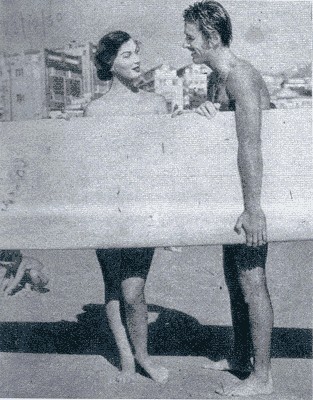 |
Left:
Peter Lawford, friend and
surfboard at Bondi,
dated 13/12/1950.
Brawley (2007). Page 216
(Bondi Surf Bathers Life Saving Club).
Right:
North Bondi Lifesaving Club
member,
Grant Turnbull, with Peter Lawford’s balsa Malibu,
Bondi, 1951.
Image courtesy of John “Red Ted”
Sullivan,
November 2016.
|

|
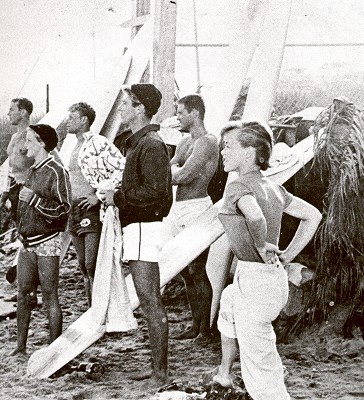 |
Actor Peter Lawford and other
Malibu Surfers,
The
Pit , Malibu, circa 1953.
Lueras
(1984) page 115.
Ricky
Grigg Collection.
|
Following Peter
Lawford's visit to Bondi, some Australian board riders
experienced the superior performance of the Malibu
board on their cross Pacific travels.
A merchant seaman, Ray The Admiral McKeon rode
hollow boards in the late 1940s and early 1950s, on
Sydney's south-side beaches.
He first visited Hawaii serving on a troop ship in WW
II at 15, falsifying his age on enlistment, and while
serving as a merchant seaman had his first rides
on finned balsa ten-footers on Oahu’s South Shore
around 1953.
He recalled I absolutely loved them, but I
couldn’t bring one home back then as I didn’t have
the dough.
Moving to Sydney’s northern beaches around 1958, Ray
worked as a sander in Gordon Woods’ new factory in
Brookvale between berths on ships and was among the first to regularly surf the breaks
along the peninsula.
John Brasen: https://www.pacificlongboarder.com/news/Farewell-Ray-The-Admiral-McKeon/
According to the Wollongong
SLSC, boardrider and member
Ted Burns rode a Malibu board when he competed in one of the early Makaha
contests.
After the first scheduled contest in 1953 failed
to provide waves, it was conducted successfully the
next year, won by
George Downing, with Rabbit Kekai the champion in1955.
"Ted
Burns competing at Makaha in 1950
-
said to be the first Australian to compete in
Hawaii."
Unknown
: Looking Forward - Looking Back :
History
of Wollongong City SLSC 1915-2000, page 27.
The
board Burns is riding is certainly a short Malibu type
board and the competition shirt conforms with other
examples in use at Makaha in this period.
The
caption obviously does not take account of the
representative Australian team to the Pan-Pacific
Games in Honolulu in 1939-1940.
Although
this era precedes the development of an extended
surfing press, surfboard designers published their
plans in popular technical or handyman magazines as
early as 1934.
Bill
Reid's 1953 article "Fun on a Plastic
Surfboard" details a 9ft 6'' board
with a long based fin constructed from a styrofoam
blank with a plywood stringer, covered in muslin cloth
and plastic sealer before fibreglassing.
|
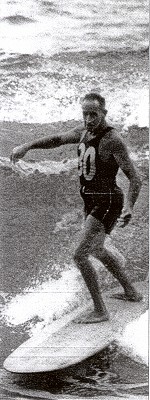 |
Californian, Matt
Kilvin provided the technical information (and was photographed)
building a fibreglassed balsa wood surfboard for Edna Wood's
1954 imaginatively titled article, "Surfboards".
Mechanix
Illustrated Magazine
September Volume 50 Number 9 pages 173 - 173.
Kilvin was a
protégé of Bob Simmons and a companion of Joe Quigg and Tom
Zahn.
His printed plans
do not feature a fin, which maybe an oversight.
Printed in the
U.S.A., it is unknown if any current copies arrived in
Australia.
Certainly,
without a demonstration of the board's performance, the impact
on an Australian reader would have been minimal.
However, it is
possible that these articles (or copies of) were in circulation
among Australian surfboard builders after 1956.
It is unlikely
that members of the U.S.A. and/or Hawaiian teams were unaware of
Kilvin's contribution.
Circa 1955
Scott Dillion and Barry "Magoo" McGuigan, members of Bondi
Surf Lifesaving Club, rode balsa boards in California at
Hermosa Beach, courtesy of local Surf Life Guard Stations.
Scott Dillon Interview by Neil
Armstrong. Longboarding Magazine, Number 5, Autumn
1999, page 23.
Scott
Dillon Interview 29th June 2005. Coffs Harbour
NSW.
In
biographical notes, published in 1964, John ‘Nipper’ Williams,
of Queenscliff S.L.S.A claims he obtained a balsa Malibu in
1955-1956, bought used in Hawaii ...
Surfing
has
been Williams' life from the time he joined Queenscliff
Surf Club at the age of 12.
He
started riding 16-foot plywood boards and believes he had
the first Malibu brought to Australia.
He rode
one he secured from a friend who had bought it in Hawaii,
in 1955, the year after actor
Peter
Lawford showed the first malibu here.
The claim is
confirmed by Manly surfer, Bob Evans ...
"...'Nipper'
Williams,
who had been using a beat-up old Malibu for six months,
also was showing form.
'Nipper's'
board
was about 8' 6" and had been brought back by a travelling
Australian businessman
for his
11 year old son six months earlier.
Everyone
else thought it was a joke - except "Nipper" and several
thousand Californians."
Bob Evans in Surfing World
Volume 16 # 4 Pages 30 to 35. 1972.
For the full
article, a retrospective covering the period from the
introduction of the malibu board 1956 to 1966, see ....Bob
Evans : Remember the time when?
In early 1956
Scott Dillon returned to Bondi from the USA and purchased a
Milacron, a job that was conducive to his surfing activities.
In mid 1956 he
encountered 'Flippy' Hoffman, a visiting American surfer,
seriously ill with yellow jaundice.
Flippy Hoffman
was a member of a famous surfing family that included Walter
and Joyce Hoffman.
While Hoffman
was hospitalized, his balsa/fibreglass semi-gun was surfed by
Scott Dillon at Bondi Beach.
The board
featured an unusual concave deck.
Scott Dillon Interview by Neil
Armstrong. Longboarding Magazine, Number 5, Autumn
1999, page 23.
Scott
Dillon,
phone conversation, 2000.
Scott
Dillon
Interview 29th June 2005. Coffs Harbour NSW.
This is
probably the board referred to by Bob Evans, his commentary
probably dating Hoffman's arrival in the later half of 1956
...
"By
chance the liner carrying home of the Americans to
Australia also carried two Australian
surfboarders
returning
from a world trip.
They were
Scott Dillon and Barry "McGoo" McGuigan and their
non-surfing mate Bruce Laird. Obsessed by the
possibilities of what they had seen of the short board in
action overseas, the boys persuaded one of the Yanks to
leave his board in their care at Bondi while he journeyed
to Victoria for the big surf carnival.
This
board, the first of its kind to be used regularly
south-side, was stored at Ross Kelly's house and was
ridden to a standstill, till its owner returned to claim
it."
Dave Simmons
recalls that "Bluey" Mayes confided that the board was highly
valued by the south side riders and effectively hidden from
Hoffman on his return to Bondi from Victoria.
Dave Simmons in conversation, Shoalhaven Heads
SLSC, 17 September 2006.
'Olympic' Preparations.
In the lead up to
the 1956 Melbourne Olympic Games, the surf life saving movement
intensively lobbied to have their sport featured as one of two
demonstration sports nominated by the host country.
Despite the
Olympic officials allocating demonstration status to Baseball
and Australian Rules Football, the arrangements for the proposed
International Surf Life Saving Carnival proceeded.
On the 5th
October 1956, the Sydney Morning Herald (SMH)
announced the forthcoming International surf life saving
program as Torquay 2nd December, Maroubra 8th December and
Collaroy 9th December, 1956.
-Page?
The program was
subsequently adjusted with the International Carnival to be held
on the 25th November, with the (delayed from 1955-1956)
Australian championships held on the following weekend, 2nd
December, 1956.
"Early
in
the 1956-1957 season, an International Surf Carnival,
regarded as the first truly international carnival (133),
and the delayed 1956 Australian Surf Championships were
held
at Torquay, Victoria on 25 November and 2 December 1956
respectively, to coincide with the Olympic Games being
held in Melbourne."
The countries
invited to compete at all events included teams from Great
Britain, New Zealand, South Africa, Ceylon, Hawaii and
United States.
U.S.A. - Hawaiian Preparations
Torquay
surfer, Peter Troy recalled
"...
Arthur Parkin. I think he's 94 years old, living in
Queensland on the Sunshine Coast, he was asked by the
lifesaving authorities in Australia to travel to
California and Hawaii to instruct paid lifeguards to be
put together into a team to come out to Australia. And
that was done I think as early as 1952 and was sponsored
by Ampol Petroleum, where they paid for that man to go
several times to America to teach these guys lifesaving
methods."
In 1953 a reprenentative team of Australian lifesavers visited
the U.S.A. and Hawaii'.
Don
Lucas
(Manager) Cronulla NSW
Harry
Clark
(Captain) Cooks Hill NSW
John
Bloomfield
Coffs
Harbour NSW
Don
Morrison
Cottesloe
WA
Alex
Norton
Burnie
TAS
Arthur
Parkyn
Mooloolaba
QLD
Brian
Whiting
Torquay
VIC
Tom
Jennings
Henley
SA
http://surfsports.slsa.com.au/default.aspx?s=australianrepteams&id=6
The California
Surf Life Saving Association historian reports
"The
Honorable Judge Adrian Curlewis of Australia appointed
Arthur Parkens (Parkyn?), an Australian lifesaving
instructor, to solicit participation from the United
States.
California
lifeguards
and a contingent from the Territory of Hawaii decided to
participate.
Both
teams were required trained and awarded, "The Australian
Surflifesavers Medallion," so as to meet the international
competition standards required for the event."
http://www.cslsa.org/about/history.asp
There is some
uncertainty to the membership and the independence of the two
teams.
Reports have
alternative spellings for many team member's names, sometimes
it is unclear to which team the member represents, and
sometimes the teams are combined under the general description
"Americans".
Some reports of
the results from the various competitions are unclear.
Furthermore,
Tom Zahn's status as a representative of Hawaii was possibly
questionable.
The (apparently
small) number of native Hawaiians in the team should also be
noted.
What is
certain is the quality of their equipment and their ability as
Watermen.
Several team
members were at the forefront of the development of the
fibreglass surfboard, protégés of Bob Simmons.
The paddle and
Malibu boards bought to Australia were built by some of the
premier American designers - Joe Quigg, George Downing and
Dale Velsey-Hap Jacobs.
Although the
term only came to prominence in the surfing press circa 1978,
see Warshaw
(2004) Pages 681 and 682, the Waterman concept was
essentially formulated by Tom Blake in the 1930s.
Blake (1935
and 1961)
promoted the idea of the fully qualified surfer, personified
in Duke Kahanamoku, whose skills not only included wave riding
but proficiency in swimming, body surfing, the paddle board,
canoe paddling, sailing, fishing, diving, rescue techniques
and equipment construction and maintenance.
Blake's ideas
were particularly taken up by Tom Zahn who was an elite
athlete, see Lynch and
Gault-Williams (2001) Pages 183 to 185.
In the early
1960s, the concept lost its status to a heavy focus on
waveriding skill that, at an extreme, was valued over all
other human traits.
That extreme
was called Micki Dora - See Steyck and
Kampion (2004).
US Team Members
Members were
selected from various Californian professional life guard
services - Los Angeles County (LACO), Los Angeles City
(LACity) and Santa Monica City (SMC).
Rusty
WilliamsTeam Captain (LACO)
"Rusty
Williams
emerged as the County's leader during this era of
increased professionalism,
which saw
the introduction of formalized training and public
education programs."
History of the County of Los Angles
Lifeguard Division
http://www.lacofd.org/Lifeguards/WhoIsHistoryByDecade.asp
Kirby
Temple Team Coach (LACO)
Herb
Barthels, Sr. Team Manager
(LACity)
Tad
Devine(SMC)
The son of
Hollywood actor, Andy Devine, Tad was an elite swimmer who
"...
missed selection on times in the United States Olympic
team
as a
400-metre swimmer by only 0.1 s."
SMH Monday 10th December, 1956. Page
11.
"In
1964, ... Howard Lee of LA County designed the national
logo ... His design was influenced
by a
similar design that Tad Devine of the 1956 Australia team
had created for the team uniform."
California Surf Life Saving Association -
History
http://www.cslsa.org/about/history.asp
Bob
Burnside(LACO) - Velzy-Jacobs surfboard
"After the
(Australian tour) ... Chief Stevenson appointed
Bob Burnside as President of the nascent organization
(SLSAmerica)"
"Bob
Burnside ... President ... of USLA 1963 - 1967"
California Surf Life Saving Association -
History
http://www.cslsa.org/about/history.asp
"Bob
Burnside became the Chief lifeguard in 1972. A founding
member of the Surf Lifesaving Association, Chief Burnside
pushed for professionalism and respect for lifeguarding with
the introduction and recognition of important credentials
such as rescue boat skipper licensing and EMT
certification."
History of the County of Los Angles
Lifeguard Division
http://www.lacofd.org/Lifeguards/WhoIsHistoryByDecade.asp
Mike Bright
(LACO)
"Mike
'Bones' Bright an Outstanding Waterman of Surfing,
Paddleboardering (sic), and Diving. A State
Champion in Beach Doubles Volleyball and a 3 time Olympic
participant, once in paddling, twice in volleyball. And who
glassed boards for Bing Copeland, Rick Stoner, Greg Noll,
Dewey Weber, Sonny Vardeman, Hap Jacobs, Dick Mobley and
others.
...
When
Mike was 15 years old he was repairing boards under the
Manhatten (sic) Beach Pier, afterwards he
would be glassing in friend's garages from Manhatten Beach
to Redondo. Trying new ideas on glassing techniques. He used
a Churchill swimfin to squeege a board, Mike liked the way
the edge of the swim fin worked the resin, but the fin was
to bulky. Back then anything was possible since no one did
it before. Mike mentions Bill Bahr was the first to get
glassing down, most of the early guys kept the information
and technique of what they did to themselves. So you learned
on your own."
http://www.theshaperstree.com/tales/bones.asp
Story by Mike
Bright, written by Tom Takao.
"Mike
"Bones" Bright was a member of the "17th Street Seals" which
was a local surfing club back in the 1950’s and 1960’s. As a
club member he was involved in surfing, paddle-boarding, and
volleyball.
...
Bright was
also a multi-winner of the Catalina-to-Manhattan Beach
Paddle Board Race. In 1955, Bright, after 32 miles on an 18
foot paddle board winning the Catalina-Palos
Verdes-Manhattan Beach paddle board race played volleyball
all day to help win the Manhattan Beach Six-Man Tournament.
He did this on several occasions, including in 1964, when
the event was two-man.
...
Mike
Bright, five time winner of the Manhattan Beach Men’s Open,
... was an All-American from 1960-1964. He played on the
1964 Olympic Team and on the 1960 Pan Am Team."
Beach Volleyball Database
http://www.bvbinfo.com/player.asp?ID=313
Greg Noll(LACO)
(Gregg Knoll ?)
Greg Noll had a
well documented surfing careeer.
Dave
Ballinger (LACO)
Chick
McIlroy(LACO)
Paul
McIlroy (LACO)
Sheridan
Byerly(LACO)
Roger
Jensen(LACO)
http://www.cslsa.org/about/history.asp
A photograph of
the U.S.A. team, location unknown, includes Arthur Pakins
from Australia and one Bud Stevenson, who is not listed
elsewhere.
His attire
indicates he is possibly an official.
http://www.theshaperstree.com/tales/bones.asp
Greg Noll notes
several team members as "Tommy Zahn, Mike Bright, Bobby
Moore and I"
Albie Thoms'
account of the 1956 tour lists "Tad Devine ... Greg Noll,
Mike Bright, Tom Zahn and others"
Hawaiian Team Members
Dr. Don
Gustuson
Harry
Shaeffer (Shaffer?) , Team Manager
Tom
Shaeffer (Shroeder?) - 9ft 6'' semi-gun
surfboard
Team Coach
Tom Moore
Tom Zahn
- probably Joe Quigg surfboard
Dan Durego
(De Rego?)
Tim
Guard- George Downing surfboard
"Tim
Guard's lifelong residency in Hawaii has revolved around
ocean related activities. As president of McCabe Hamilton
& Renny Co., he presides over the state's largest and
oldest stevedoring business. He earned his BA from the
University of Southern California in International
Relations and served as an officer in the U.S. Navy during
the Vietnam era, where his combat citations were the
Bronze Star and Navy Commendation Medal. Guard's civic
service leadership roles include the Hawaii Maritime
Center, Outrigger Canoe Club and Honolulu Council of the
Navy League, for which he currently serves as president.
Prior to joining McCabe, he owned and operated his own
executive recruiting company, Robert T. Guard &
Associates."
Pacific Marine Life Foundation : Board of
Directors
http://www.pmlf.org/pages/bios.html
L. Honka
(Hangca?)
Peter
Balding (Baulding?)
Shaky Felez
The above team
lists are based on those at http://www.cslsa.org/about/history.asp
Bob Green
noted in November 2012:
Peter Balding
Dan de Rego
Reginald Nainoa 'Sharkey' Fellezs
Tim Guard
Don Gustuson
Luis Hangca
Tom Moore
Tom Schroeder
Harry Shaffer
Tom Zahn
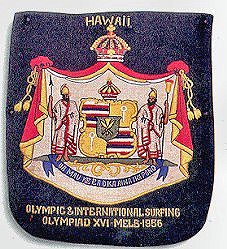
|
Tom Zahn's Hawaiian team cloth
badge
International
Surfing
Carnival, 1956.
The
Surfer's Journal
Volume
9 No 2, 2000. Page 86.
Photograph
: unaccredited.
|
"The Hawaii team consisted of ten members
including Peter Balding, Tom Zahn, Tom Moore, Tommy
Shroeder, Harry Shaffer and Danny De Rego."
Patterson
page 96
Accompanying
the Hawaiian Team in Melbourne was Duke Kahanamoku,
returning to Australia as a guest of the Australian Olympic
Committee
US Team Arrival Anticipated
The Sunday
Telegraph, Sunday 11 November 1956 Page 84, noted ...
U.S. Team
for surf
Twelve
American and 10 Hawaiian lifesavers will arrive here on
Tuesday to compete in surf carnivals
in
Melbourne and Sydney.
They will
be the first lifesavers from America and Hawaii to compete
in carnivals in Australia.
The
Americans and the Hawaiians will appear at Torquay
(Victoria) on November 25 and December 2
and at
Maroubra and Collaroy on December 8 and 9.
The
Americans and Hawaiians will make their first appearance
in Australia at carnivals next weekend at Cronulla and
Avalon.
Under a
header "U.S. Surf team Will Tour'', a SMH
article (11th October, 1956. Page 8) notes that the team will
arrive in in Sydney in November and the success of the
Carnival is due to a donation of two thousand pounds from Mr.
G Walkley of Ampol.
Arrival in Sydney - Tuesday 13th November 1956.
Members of the
US and Hawaiian teams arrived in Sydney on Tuesday 13th
November 1956.
SMH 14 November 1956 Page ?
Daily
Telegraph 14 November 1956 Page 31.
The Sun Wednesday
14th
November 1956 Page 60.
Noll's
narrative, and contemporary film, indicates that the teams and
the Malibu boards arrived by air ...
"Tom
Zahn, Mike Bright, Bobby Moore and I paid the extra
freight
to take our surfboards with us to Australia ... When the
boards
were
first taken off the airplane and put on a flatbed truck
...". Noll
(1989) Page 70.
It is probable
that the larger paddleboards were also in the same shipment.
There is a slight
possibility, with lengths exceeding 14 feet, they came by sea
freight.
Noll records
the initial Australian response to the new design was a mix of
scepticism and laconic humour ..
"...
a head honcho (unidentified) from one of
the surf clubs in Australia came over to look at them.
'What are
these for, mate?" he asked us.
... This
guy kept looking at the boards, touching them, turning
them over.
He
finally said, 'Give ya two bob (two shillings,
later 20 cents) for the works, mate.'
His way
of saying they were worthless." Noll
(1989) Page 70.
Note that Greg
Noll's assessment of Australian boardriding at this time is
less than accurate...
"Up
to that time, the Aussies had used a surf ski type of
board,
and the
idea was to go out and take off on some white water and
come
straight in in the soup, while all the girls on the beach
squealed." Noll(1989)
Page
70.
This may possibly
be a casual assessment of current surf life saving and
competition practice, but from the early 1940s Manly boardriders
regularly rode at Fairy Bower, a powerful right hand point/reef
break where to "take off on some white water and come
straight in in the soup" is not a practical option.
Cover : Walkabout - Australia and
the South Seas Magazine October 1, 1942.
Although
Noll's account appears to suggest the inclusion of the Malibu
boards was almost incidental ...
"We
intended to take the boards with us to the paddle meets
and,
during
our time off, tryout the Australian surf."
from their first
contact with the Australian press, the US-Hawaiian surfers were
expansive in their enthusiasm for their new fibreglassed
surfboard designs.
The day after
the U.S.A.-Hawaiian teams' arrival, the SMH
headlined an article "Ultra-Light Board for
Surf"...
"Hawaiian
lifesaver Henry Shaffer (sic, Shaeffer)
believes his 26lb board could revolutionise surfboard
racing (1) in Australia.
Shaffer
is captain of the Hawaiian surf team, which arrived in
Sydney yesterday with 10 American
lifesavers
to
compete in international surf carnivals in Melbourne and
Sydney during the next month.
The most
streamlined racing boards in Sydney, made from 1/2
in (half inch) plywood, weigh about
33-35 lb.
Shaffer's
surfboard is made of balsa wood reinforced with canvas,
and is coated with a thick layer of
fibre-glass.(2)
Several
leading Sydney board riders agreed last night that the
lightweight balsa fibre-glass boards
would
give the Hawaiians a tremendous advantage under normal
conditions.(3)
But they
claimed the heavier Australian boards would be more at
home in a big surf, where the
Hawaiian
boards would be at a disadvantage.
Shaffer
said: "I must admit that the powerful Australian surf will
be the final test for the fibre-glass
board (4),
which has just come into vogue in the United States."(5)
The
Americans, all powerful rough-water swimmers are
university graduates or students, who spend
the
summer as professional lifeguards on beaches around Los
Angeles.
The
Hawaiian and American teams will be billeted at the
Balmoral Naval Depot (6) until they leave for
Melbourne
next Wednesday.
They wiII
compete in carnivals at Torquay on November 25 and
December 2, returning to Sydney on
December
6 for carnivals at Maroubra, Dec. 8, and Collaroy, Dec. 9.
"
SMH 14th November, 1956. Page?
Commentary
1.
"revolutionise surfboard racing"
The boards
referred to are likely paddleboards, and not the wave riding
Malibus.
2. "made of
balsa wood reinforced with canvas, and is coated with a
thick layer of fibre-glass."
For a reference
to "reinforced with canvas", see Bill Reid's 1953
article "Fun on a Plastic Surfboard"
Popular
Mechanics Magazine July 1953 Volume 100 Number
1 page 159 .
3. "...
Sydney board riders agreed ... the lightweight ... boards
... give ... advantage".
Australian
builders have noted the advantages and, even at this early
juncture, have possibly examined the boards.
4. "the
powerful Australian surf will be the final test for the
fibre-glass board".
Indicates the
board design has been paddled, and ridden, in an extensive
variety of surf conditions, so far successfully.
5. "which
has just come into vogue in the United States."
The design
is only recently become popular in California and Hawaii.
6. "billeted
at
the Balmoral Naval Depot "
Gordon Woods
recalled that they were accommodated at the Army barracks on
North Head, significantly closer to Manly
beach. Gordon Woods, my notes from a
phone conversation, 18th July 2005.
In correspondence with Eric Middldorp,
Freshwater SLSC member Don Henderson recalls the members of the
American and Hawaiian Teams visit to Freshwater Beach November
1956 were:
| "Hawaiian Team.
Dan De Rego, Tom Zahn, Peter
Balding, Lew Hanka, Ralph Kanoho, Tom Moore, Henry
Kanoho, Reginald Fellaze, Tom Schoeder, Don Gustuson,
Harry Schaffer (Delegate)."
He also forwarded a photograph "of Tom Zahn who was
the Hawaiian Board Champion.
The photo was taken at Mona Vale Northern Beach surf
carnival.
The board was 16ft. with a timber frame with a rubber
skin over it.
He went down a wave and snapped it in half.
I won the board race that day."
- Thanks to Eric and Don.
|
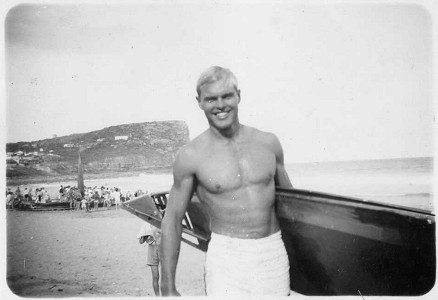 |
As the teams were accommodated adjacent to
Manly, a major research resource should be The Manly
Daily.
Unfortunately,
for reasons unknown, the paper failed to archive copies circa
1955-1958 and none are held by the Manly-Warringah Library.
There is no
mention of the provision of equipment storage or for training
facilities of the visiting teams, the latter certainly
requiring access to surfing conditions.
Since Manly
Beach was the closest surfing beach to the teams accommodation
at Balmoral, it is the most likely available training centre,
with equipment storage facilities at any of the beach's three
surf lifesaving clubs.
Manly surfers
had reason to closely monitor the overseas competition.
The Manly SLSC
sent a team of 27 to the Torquay carnivals, contesting a
variety of events.
Unfortunately,
star Manly swimmer Max Riddington was working in America and
was not available for selection.
His place fell
to another Manly club member, Barry Taylor.
Harris
(1961) Page Twenty-nine.
Furthermore,
Manly was one of the major centres of boardriding in Sydney,
with a pedigree dating back to Claude West, the recipient of
Duke Kahanamoku's Freshwater board in 1915.
West's impressive
contest record was continued by his Manly protégé, 'Snowy'
McAllister who
"...
competed in the surfboard race at the Australian surf
championships at Torquay,
Victoria
in 1956 - 32 years after winning his first title."
The Manly club's
interest in surfcraft was not confined to surfboards and members
played a major role in the development of the Australian
surfboat and the surf ski.
The Sun
journalist covering the arrival, J. S. McAuley, briefly
mentioned the new surfboard design, but gave most
prominence to Tom Zahn's paddling abilities ...
"Hawaiian
Tom Zahn will not lack staying power when he contests
board contests at the Olympic surf carnival at Torquay on
Sunday week.
Zahn
recently won a 26 mile race in Hawaii.
The
longest board races in NSW are about three miles.
With the
revolutionary type boards the Hawaiians have brought with
them they could trouble our top riders."
He also gave
details of the team's competitive attire ...
"US and
Hawaiian surfers will wear colorful costumes (donated
by Speedo) for their first Australian appearance at
Cronulla on Saturday and at Avalon on Sunday."
Some details
in the article were, or proved to be, incorrect ...
"The
Americans are coastguards from Miami Beach, Florida.
They will
not be allowed to contest individual events, as they are
paid professionals."
J. S. McAuley : In The Surf
The Sun Wednesday
14th
November 1956 Page 60.
Cronulla Beach - Saturday 17th November 1956.
In a brief
report focused on the skill of the U.S.A. team, the Sunday
Telegraph (Sunday 18 November Page 76) reported ...
"U.S. surfers impressive
The
visiting American surf team yesterday showed it could
prove a major threat to Australia's domination of
international surfing.
The
Americans trained impressively before a crowd of 4000 at
Cronulla beach."
Avalon Beach - Sunday 18th November 1956.
The first
public, and most significant, demonstration of the performance
capabilities of the Malibu boards was on Sunday 18th November
at Avalon beach, on the Northern beaches peninsular.
The SMH
reported (19th November, 1956. Page 3) in an article titled "Thousands
Throng Beaches : Many Saved. US Surfers Show New
Technique" ...
"Nearly
20,000 went to Avalon for the surf life saving carnival
in which lifesavers
from
United States, Hawaii and New Zealand competed
against Sydney clubs.
The
American surfers, standing sideways on small 10ft.
boards and moving
at high
speed, received a warm reception from the crowd.
One of
the American surfers, Ted Levine (sic, Tad
Devine) had the opportunity to
demonstrate
his
country's rescue technique in a genuine emergency.
Instead
of the Australian belt and reel, he used a "torpedo
buoy' ".
For a detailed
account of the use of the Torpedo buoy and it's assessment by
Australian lifesaving officials, see the entry for the Collaroy
International Carnival, Sunday 9th December 1956, below.
Wollongong - November 1956, undated, but before
Wednesday 24th.
"During
the
year (1956), Olympic swimmers, Lorraine Crapp, Gary
Chapman,
plus
coach Frank Gutherie were entertained at the Illawarra
Leagues Club.
Also at
the same venue, the club entertained the U.S.A. and
Hawaiian teams in November,
prior to
the International Carnival at Torquay, during the Olympic
Games."
The Corfu Lifebuoy - History of North
Woolongong Surf Life Saving Club 1908-1996.
Pages 85 - 86.
Departure for Melbourne - Wednesday 21st November
1956.
In the
period before the departure for Melbourne, Gordon Woods
arranged to purchase a 9 ft 6” Velzy-Jacobs surfboard
from Bob Burnside.
As
Burnside required the board for competition, exclusive
possession would only be available to Woods when the
teams returned to the U.S.A.
To make
certain of the deal, concerned that Burnside may receive
a more attractive offer, Gordon Woods travelled to
Torquay.
As future
owner, he was able to surf the board, his first exposure
to Victorian waves.
Gordon Woods, my notes
from a phone conversation, 18th July 2005.
Image
right : Gordon Woods and his Velzy-Jacobs
Malibu board, circa 1958.
Cropped
from Pollard
(1964) Page 28.
Two
other boards were known to be purchased by Manly
surfers, Bob Pike and Bob Evans, and given the
Burnside-Woods arrangement it is possible that these
were similar transactions.
|
|
Bob Pike
purchased a 9 ft 6” Malibu from either Ted (sic) Schroeder or
Tom Zahn
Bob
Evans (1972) and Nat's
History (1983) Page 89.
Ray Moran (phone
conversation, 23 August 2006) reports a tale from a Manly SLSC
member that when the visitors left their boards at the club to
venture down the Corso, Pike was invited by an unauthorized
Manly member to try out one of the newly arrived boards.
Upon the return
of visitors, Bob quickly rode the board into the beach under a
hail of verbal abuse and desperately attempted to make amends by
insisting that he wanted to buy the board.
Bob Pike was a
big wave rider, noted for his Hawaiian performance.
He was the first
Australian surfer to win an international contest, Peru 1962.
Bob Evans
obtained a board (probably) built in Hawaii by North shore
pioneer, George Downing ...
"Gordon
Woods
bought a 9' 6" Malibu type, Bob Pike acquired a 9' 6"
semi-gun from Ted (sic, Tom) Schroeder and I
paid Tim Guard 46 (pounds) for a beautiful, hot
curl board built by George Downing."
Bob
Evans : remember the time when...' Surfing
World Volume 16 # 4 1972 pages 30 to 35.
Note that this
probably was not an original finless Hot Curl, circa 1937 but a
later finned model based on the Hot Curl template.
Bob Evans was a
surfing photographer and future editor of Surfing
World magazine and prolific surf film producer.
Nat
Young (1983) also reports that ..."Peter
Clare (bought) a Quigg board"
- page 89.
This claim is
repeated (but probably the source is Young) by Walding
(2003) page 25.
None of the
reports appear to account for Greg Noll's (possibly self-made)
board which he confirms was onsold
"When
we
left Australia, we also left our boards for the Aussies."
Note that Peter
Troy specifically notes Noll's board had a removable fin, see
the entry for Torquay, Sunday 2nd November 1956, below.
A report in
the SMH clearly indicates that seven Malibu boards of the
Hawaiian team will be onsold to Australian surfers at the end
of the tour...
"Surfers
To Sell Boards
The
visiting Hawaiian surfers will sell their seven
lightweight surfboards (1), which created a
sensation at Avalon last Sunday (2), after their
farewell appearance at Collaroy on December 9.
The
boards, which are made from balsa reinforced with two long
strips of redwood (3) and coated
with a
thick layer of fibre-glass, weigh 26lb.
The
lightest racing boards in Sydney, made from 1/2 inch
plywood weigh from 33 to 23 lb.
The
Hawaiian boards, which have been used at Waikiki Beach for
seven or eight years (4), can be made in less than
a week.
Shorter,
Wider
They are
eight feet long, compared with the average Australian
length of 16 feet, but are about five
inches
wider than the local board's 20-21 inches.(5)
Three
hundred people saw the Hawaiians give an exhibition of
board riding after a special carnival at
Avalon in
a big surf last Sunday.(2)
Unlike
Australian boardriders, the Hawaiians stood on the middle
of their balsa boards, even when
heavy
white water from the broken waves swept around their feet.
Harry
Shaffer, captain of the Hawaiian squad, said last night of
the boards : "There is no question of
selling
out to the highest bidder.
"We plan
to give our boards to the fellows we consider to be the
real enthusiasts at only a token
cost."
SMH Wednesday 21 November, 1956. Page
15.
Commentary
1. "seven
lightweight surfboards"
The boards as
described are definitely Malibus, approximately 8 feet long.
This possibly
only refers to boards from the Hawaiian team.
The number of
boards from the U.S.A. team is unknown.
See below.
2. "which
created a sensation ...Three hundred people saw the
Hawaiians give an exhibition of board riding after a special
carnival at Avalon in a big surf last Sunday."
The report
closely aligns with Greg Noll's recollections, that commentators
often locate at Torquay.
See Noll (1989),
Page 71, quoted above.
3.
"reinforced with two long strips of redwood"
.The presence of
redwood stringers is not noted in any other report.
In film of Duke
Kahanamoku's visit to Freshwater Beach following the Olympic
Games, reproduced in Nat Young's A History of Australian
Surfing (1985), one board of the accompanying
U.S.A.-Hawaiian riders appears to conform with this description.
See Freshwater -
December 1956, below. 4. "used at
Waikiki Beach for seven or eight years"
Estimates the
introduction of the fibreglassed boards to Waikiki circa 1949.
5. "about
five inches wider than the local board's 20-21 inches."
It is unlikely
that any of the balsa and fibreglass boards width exceeded 24
inches, but it is possible.
6. "in a
big surf last Sunday."
The contrast
between this report's "big surf" with Greg Noll's "a
little point break" (see above) maybe be explained by
Noll's, often quoted, extreme method of estimating wave height
in "increments of fear".
Noll was one of
the first surfers to regularly ride the large waves of Oahu's
north shore in the 1950s, his performance at Waimea Bay and
Outside Pipeline is well documented.
Wednesday's SMHreport
indicates
that at least seven boards from Hawaii are to be on-sold to
Australian boardriders.
It is unclear
if this is the total number of boards, or if other boards were
available from the U.S.A. team.
Of the boards
identified above, two came from Hawaiian team members
(Schroeder or Zahn and Guard) and one from the U.S.A. team
(Burnside).
Nat Young's
report that "Peter Clare (bought)
a Quigg board". does not identify the
previous owner, boards by Joe Quigg were in use in both Hawaii
and
California. Nat
Young (1983) Page 89
There are, at
least, three boards unaccounted for.
It is known
that Greg Noll and Mike Bright brought Malibu boards to
Australia, however their fate is currently unknown.
A remote
possibility is that one transaction may have included an
exchange of craft, at least one Australian surf ski probably
returning with a member of the Hawaiian team.
In a
report despatched from Melbourne and published on the day of
departure, The Sun's J. S. McAuley detailed
accommodation and catering arrangements for the competitors
...
"Australian
and
overseas surfers billeted at Melbourne Showground will not
go short of meals during their 12-day stay. Frank Dennis,
who is doing the catering at Melbourne Stadium during the
Games, is also looking after the surfers. He has ordered
nearly two tons of beef, to be eaten at breakfast. He is
providing a la carte dinners for the 350 surfers at
night."
J. S. McAuley : Surfers to Eat by '
Ton'
The Sun
Wednesday 21st November 1956 Page 59.
Subsequent
reports indicate a less than positive assessment of Frank
Dennis' culinary skills ...
"Many
of
the competitors were less than happy because they were
housed at the Melbourne
Showgrounds
and
there were mountains of complaints about the bulk food
catering.
Lou
Vaughan, of Burleigh Heads, and his mate 'Whoopsie'
Phipps, of Surfers Paradise,
told me,
'It was worse than horsemeat. ' "
Torquay Beach - Sunday 25th November 1956 :
International Carnival
An Australian
(Melbourne?) newspaper article, "Torquay Prepares for
International Surfing Carnival "(25th November
1956?) detailed team training activities and noted, once more,
the use of fibreglassed boards ...
The
Americans were particularly interested in the performance
of boats and boards yesterday.
Manager
Kirby Temple pointed out that the only surf boat used
at Los
Angles was a Gloster (?) dory, manned
by two rowers.
Americans
also use a different type of board.
It
measures about nine feet, and is made of balsa wood
covered in fibreglass.
The newspaper article is reproduced in Walding,
page 17.
In
another article previewing Sunday's carnival, Melbourne's The
Age notes the attendance of international teams,
possible highlights of the day's events and the expectation of
a large number of spectators ...
"With
Olympic
athletes observing a rest from competition,
a crowd
of thousands is expected to make the journey."
There is no
mention of the U.S.A. or Hawaiian teams' surfboards.
The Age Saturday 24th November 1956
Page 12.
Duke
Kahanamoku attended at least one of the carnivals at
Torquay, probably the first.
He
returned to Australia for the 1956 Melbourne Olympic
Games, where he and Mrs. (Nadine) Kahanamoku official
guests of the Australian Olympic Organizing Committee.
Image
right :
Duke
and Nadine Kahanamoku
International
Surf
Carnival, Torquay Victoria, 1956.
Myers
(1983) Page 18 and Galton,
(1984) Page 108.
|
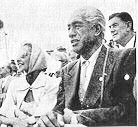
|
Following the
competition, the Daily Telegraph reported ...
"Surfing draws 50,000
Melbourne,
Sun.
- Fifty
thousand people today saw 35 teams compete in an
international carnival at Torquay.
...
The
Americans caused a surprise when they appeared with their
surfboards.
Glass Boards
The
boards were made of light fibre glass.
They were
very narrow, with rounded keels and resembled kayak
canoes.
Australia's
reel
and line method of surf rescue astounded the Americans.
The
American system is to carry a coil of nylon line into the
surf and pay it out as they swim to the patient."
Daily Telegraph Monday 26 November Page
35.
Note that the
board description implies the fibreglass boards are probably the
paddleboards, identified above, and the account of the the "American
system" is misleading.
For a detailed
account of the use of the Torpedo buoy and it's assessment by
Australian lifesaving officials, see the entry for the Collaroy
International Carnival, Sunday 9th December 1956, below.
The Age's
coverage of the contest reported a more modest number of
spectators and disappointing swell conditions ...
"Forty
thousand people, yesterday swarmed over the cliffs
at the Toquay beach to watch the International Surf
Carnival.
Overseas
Olympic visitors and athletes were well represented in the
crowd.
...
Despite
high winds the surf was weak and spasmodic and competitors
got little help from it.
Passing
showers sent the crowds scurrying for cover during the
morning, but the sun shone brightly for most of the
afternoon.
Overseas
visitors did not see the typically Australian sport of
surfing at its best because of the poor surf."
The article
makes no reference to the use of fibreglass and balsa wood
surfboards and an extensive list of results, printed in a
separate section, does not include board, surf ski or
surfboat events.
The Age Monday 26th November 1956 Pages
3 and 13.
World surf stars thrill crowd
By
JUDY JOY DAVIES
Tall, bronzed life-savers in their brightly col ored
uniforms, slowly ¡land majestically marched across the sands of
Torquay yesterday - and 1 70,000 people cheered one of the most
spectacular scenes of our Olympic Games Carnival.
Thirty-five teams representing the U.S.A., Hawaii, Ceylon,
South Africa, New Zealand, Great Britain, and local and
interstate surf life saving clubs-competed in the international
surf carnival.
From 10 a.m. to 4 p.m. the events continued non-stop.
As the crowds increased, they packed the
beach, then the headland - soon cars took over the golf course.
And then the tide turned, and coming in
shore, started nibbling the golden beach away.
The colorful march past was put forward an hour to 1 p.m.
- and even then there was hardly enough beach left for the 35
bronzed and youthful teams to march on.
Wearing colorful costumes of blue tops with white stars, a
white centre band, and scarlet trunks, the U.S. team brought
cheers from the huge crowd.
But the more experienced New Zealanders won the
international march past, with Ceylon second, and South Africa
third.
White-haired Duke Kahanamouku, sheriff of Hawaii and
former dual Olympic swimming champion, sat among the carnival
crowd with Australian "Boy" Charlton, another former Olym pian.
"It's great," the Duke said, "the sight of surf always
thrills me."
But for once the Torquay surf was rather tame, no boats
were up ended and the small waves were hard to
catch.
The Americans caused a surprise when they appeared with
their version of surf boards.
Very narrow, and made of light fibre glass, they proved a
lot faster than the normal Australian board.
Astonded!
And our reel-and-Iine method of surf rescue astounded them!
The American idea is to carry a coil of nylon line into
the surf and play it out as they swim to the patient.
They wear no belt attached to a reel, as we do here. ¡j
Judge Adrian Curlewis, Australia Surf Life Saving
Association president, said the international Olympic carnival
had brought about an exchange of ideas - the Americans were
going to try our reel-and-line method, and we would experiment
with their torpedo line.
Judge Curlewis added that an international advisory surf
committee would now be formed.
Hawaii won the International beach relay from South Africa
and the U.S.
Tom Zahn, of Hawaii, won the board race from Mike Bright,
of U.S., and G. Williams, of Western Australia.
New South Wales won the interstate rescue and resucitation
from Queensland and Western Australia.
Jim Fountain, of Victoria, won the senior interstate belt
race from R. Hounslow, of Western Australia, and R. Reid, of
South Australia.
The Americans claim the Australian reel and line is
cumbersome, and that the "torpedo" would halve
rescue time.
The nylon line is in a rubber buoy fastened under the
patient's arms.
Trove
1956 'World surf stars thrill crowd.', The Argus (Melbourne,
Vic. : 1848 - 1957), 26 November, p. 9, viewed 2 October, 2013,
http://nla.gov.au/nla.news-article71768013
Barry Galton
report of the contest results includes ...
"Overall,
the
New South Wales team ... won the contest from New
Zealand's team ...
Hawaii
came third. ... Hawaii won the Beach Relay from South
Africa and the
United
States and the Hawaiian T. Zahn won the Surf Board from
American M. Bright.
This was
the first time the American malibus had been given a
trying test out in the Australian surf."
His last
statement is both possibly misleading and incorrect.
Compare
Galton's reported results with the claim by the Cronulla Club,
noted by Faye Young ...
"At the
International Carnival (Torquay, 25th November),
the (Cronulla) Club won the ...Surf Board
Race..."
Although
the Malibu board had already made an indelible mark on Sydney
boardriders, the Torquay Carnivals widened exposure to surfers
from other countries and other Australian states.
Queensland
boardrider and manufacturer, Hayden Kenny stated...
"I first
came in contact with a malibu board at Torquay beach in
Victoria in November of 1956 at the Olympic Games Surf
Carnival.
The coach
of the Californian team, a Mr Arthur Parkyn (Parkens?),
who is a foundation member of Mooloolaba Surf Club,
introduced me to some of the Californian Team members who
had malibu boards with them. I was able to take one of the
boards out for a few waves that day and was immediately
impressed with the wave riding capabilities of the craft.
And from
that day on I was hooked!".
Hayden Kenny, reported at
http://www.surfingaustralia.com/article.aspx?nid=3641

Australian
Surf
Championships, XVI Olympiad 1956, Torquay Vic., Alloy
memento
This rare and interesting item was
contributed by Gary O’Donnell, November 2012.
Gary noted :
"This memento was given to my Father,
Michael O’Donnell, (who) was a member of Torquay SLSC, was
in the group that first surfed Bells in 1948-9, and he
chopped the first walkway to Bells Beach with his Axe .
I thought you
might like a copy of this one as originals are very
rare, I have seen a painted one at Torquay surf museum but
no other." (edited).
Indicative of the
versatility of American Easi-Bild patterns is this smart,
serviceable surf board.
Thousands of surf
devotees have hankered after a surfboard, but the high
cost of the commercially made article has ruled
out ownership for them.
Now you can build your way to riding the waves on
this 10-ft. surfboard with an American
Easi-Bild Pattern. No. 247, that makes construction absurdly
simple.
Pattern price, only .. 7/6.
IF YOU HAVE DIFFICULTY IN OBTAINING YOUR
AMERICAN EASI-BILD PATTERNS, WRITE IMMEDIATELY TO:
AMERICAN EASI-BILD PATTERNS PTY. LTD.
QUEENS BRIDGE SQUARE, SOUTH MELBOURNE |
6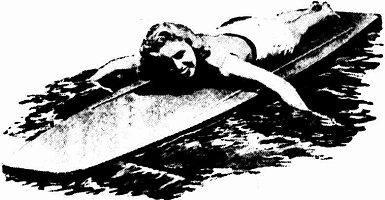
|
Trove
1956 'Advertising.', The Argus (Melbourne, Vic. : 1848 -
1957), 4 December, p. 19, viewed 2 October, 2013,
http://nla.gov.au/nla.news-article71769354
EXTRA IMAGES
Arthur Parkyn of Mooloolaba riding a wooden surfboard made by
the Hawaiian forefather of surfing Duke Kahanamoku in Hawaii ,
ca 1940
https://sunshinecoast.spydus.com/cgi-bin/spydus.exe/ENQ/PIC/BIBENQ?IRN=449753&FMT=PA
Arthur and Del Parkyn of Mooloolaba on their wedding day
in Honolulu, Hawaii,
http://trove.nla.gov.au/work/191354583?q=surf+1956&c=picture&versionId=208826201
Del Parkyn of Mooloolaba opening wedding gifts after her
marriage to Arthur Parkyn on 22 September, 1956 in Honolulu
https://sunshinecoast.spydus.com/cgi-bin/spydus.exe/ENQ/PIC/BIBENQ?IRN=452819&FMT=PA
Arthur Parkyn Australian Surf Life Saver seated in the
middle of Hawaiian Life Guards, ca 1956
https://sunshinecoast.spydus.com/cgi-bin/spydus.exe/ENQ/PIC/BIBENQ?IRN=452639&FMT=PA
Members of the Hawaiian Surf Team life guards and their
partners enjoy a party in Honolulu, ca 1956
https://sunshinecoast.spydus.com/cgi-bin/spydus.exe/ENQ/PIC/BIBENQ?IRN=453344&FMT=PA
Collaroy Beach, near Sydney, during an international surf
carnival held during December 1956
http://recordsearch.naa.gov.au/scripts/PhotoSearchItemDetail.asp?M=0&B=8363429&SE=1
United States took part in an international surf carnival
on Collaroy Beach,
http://recordsearch.naa.gov.au/scripts/PhotoSearchItemDetail.asp?M=0&B=11364638&SE=1
Flags of two Surf Life Saving Association International
Teams USA and Hawaii which were presented to their Australian
coach Arthur Parkyn pictured, November, 1956
https://sunshinecoast.spydus.com/cgi-bin/spydus.exe/ENQ/PIC/BIBENQ?IRN=453353&FMT=PA
Australian Arthur Parkyn returning the
World Titles banner from the World Titles Surf Life Saving
competition held at Torquay, Victoria in 1956, ca. 1998
https://sunshinecoast.spydus.com/cgi-bin/spydus.exe/ENQ/PIC/BIBENQ?IRN=453392&FMT=PA
Torquay Beach - Sunday 2nd
December 1956.
The SMH (Monday
3rd
December, 1956. Page 12) reported
"Melbourne,
Sunday.
Only about
15,000 watched the championships.
There was
hardly any surf and by early afternoon the tide was well out
to sea, leaving swimmers a
long run
and wade to deep water.
The march past
was marred by a storm and ... a second storm cleared the
beach and the sandhills later."
"At
the Australian Championships (Torquay, 2nd
December)... Brian Keane (Cronulla)
was
placed second in the Surf Board Championship"
Torquay surfer,
Peter Troy recalled his role at the 2nd December carnival for
ABC Radio ....
"I was not
in the official team, I was only seventeen at the time, I
was asked to give demonstration surfboard riding. I rode one
of those early surf club boards(1), to show the
standard of surfing within this country." But it was
the American team that helped inspire the surfing culture in
Australia, "in the American lifeguard team, the major people
were the lifeguards, basically swimmers.(2) In that
team they brought out with them four Malibu boards.(3)
It was Greg Noll on the second of December (4) who
rode a surfboard on Torquay back beach (5) on a
Sunday afternoon, and changed the life of surfing in
Australia for so many people. It was totally revolutionary,
the board itself was something like nine foot long.
"We were
riding sixteen and seventeen foot long boards. We knelt on
them in general, we didn't have fins on the bottom of the
board. Here's a guy walking down the beach with this
strange little thing, and jumps on it and lies down, and
everyone who was watching was thinking 'this guy isn't
very good he can't even kneel!' (6) Fifty meters
out from the beach he spun it around, caught a wave,
walked up and down, hung toes over the nose, and did
things we'd never seen before! That, basically was the
reason we walked away from surf lifesaving, we wanted to
learn to shape one of these things. The boards were taken
with them after that weekend, we had nothing to copy. (7)
We all started from scratch."
Peter Troy: pioneer surfer
ABC Radio
(Gold & Tweed Coasts) Friday, 4 August 2006.
http://www.abc.net.au/goldcoast/stories/s1705022.htm
Commentary
1. "I rode
one of those early surf club boards"
Peter Troy's role
is expanded in a later radio program, noted below.
2 "the
major people were the lifeguards, basically swimmers."
A
under-estimation of the surf skills of the U.S.A. and Hawaiian
team members, see comments on the Waterman concept,
above.
3. "four
Malibu boards"
There is no
mention of the fibreglassed paddeboards.
4. "the
second of December"
Peter Troy's
recollections clearly refer only to the second Torquay carnival.
5. "Torquay
back beach"
Possibly as a
result of the lack of swell at Torquay as noted by the SMH (Monday
3rd December), above.
6. " 'this
guy isn't very good he can't even kneel!' "
Repeated in a
later radio program, noted below.
7. "The
boards were taken with them after that weekend, we had
nothing to copy."
The boards were,
no doubt, by now allocated to various Sydney surfers.
Later in
2006, Peter Troy was interviewed again, his further
recollections add some relevant details.
"...
Arthur Parkin. I think he's 94 years old, living in
Queensland on the Sunshine Coast, he was asked by the
lifesaving authorities in Australia to travel to
California and Hawaii to instruct paid lifeguards to be
put together into a team to come out to Australia. And
that was done I think as early as 1952 and was sponsored
by Ampol Petroleum, where they paid for that man to go
several times to America to teach these guys lifesaving
methods.(1)
At the
same time, two of us, and I'm talking about another fellow
called Vic Tantau (2), and
myself, we were asked to give a demonstration of the early
surfboard riding because of what we'd developed. So I was
very fortunate to have been selected to give a
demonstration of surfboard riding.
We
basically went out on the 16-foot toothpicks, and Torquay
beach is a very special beach for this because there's a
large exposed rock off the beach called Haystack Rock, and
the way it's come in on an angle on there, and they go off
breaking towards the right, down into the middle of
Torquay back beach, and it allows maybe a 300-metre ride
on one of these surfboards.(3)
I
distinctly remember being under the Torquay surf club,
which was an elevated building up on lamp-posts, and they
had all of the surf craft underneath, and I went under
there to get something, and there was one of these
American guys, and he was kneeling in the sand, and he was
wrapping around a fin that he'd taken out of a little
handbag that had his towel and bathers and everything in
it, and he was wrapping newspaper around the edge, and
putting it into a slot in the surfboard. And he picked up
a piece of rock that was in the sand and he was hammering
this fin into the surfboard. And of course I had no
awareness of what this was about, so I was interested.(4)
I hadn't
had the opportunity of ever talking to the guy, so I was
just looking at him, and followed him down the beach and
there was probably 8 or 10 other people on the beach that
followed this guy down, carrying the surfboard under his
arm, and he got into the water, (maybe it was 4 o'clock in
the afternoon, I'm not quite sure) and lay on it, and of
course we looked at that and thought, Well he's not very
proficient because he can't even kneel on the surfboard,
he's lying on it. And then we thought he wasn't very good
either, because he only went 40 or 50 metres off the
beach, and that was the last time we thought like that,
because immediately he turned around, caught a wave in
about three paddles, stood up, and crossed the wave, and
then hot-dogged backwards and forwards, walking up and
down the board, and we were all just - (Mick O'Regan:
Gobsmacked?) Exactly.(5)
Well a
couple of us went up to him, and we asked him, 'Can I have
a go?' and I distinctly remember having a go on this
board, but I couldn't really paddle the thing, and when I
did try to stand up on it, it was so responsive, that it
flipped out from underneath me (6), and so that
was our only contact (1), because by that night,
those guys had gone back to Geelong into their hotels (7),
they'd packed their belongings and they were gone to
Sydney. So the people who were on the beach that night had
virtually two hours to think about it, and then they were
going home to Melbourne, or to Ballarat, or Geelong, or
somewhere, and within one or two weeks, those guys that
were fairly competent with their hands had gone into their
yards and tried to make one themselves. But they didn't
have the material, so they had to make them out of marine
ply with hardwood rails and they had bulkheads in the
board rather like a small craft, and holes through those
so that -
The four
surfboards (8) that we knew those guys had, had
gone that particular night, they'd gone to Sydney, and we
now know that those four surfboards were bought by
individuals in Sydney, and so Gordon Woods and Bob Evans
and Bob Pike (9), other people in Sydney that
acquired those boards, had the opportunity then of being
able to copy them. But we in Victoria didn't, so we had to
start off with just pure memory." (10)
Peter Troy : The Sports Factor. Presenter
: Mick O'Regan
ABC Radio
National Friday, 22 September 2006.
http://www.abc.net.au/rn/sportsfactor/stories/2006/1743137.htm#
Commentary
1. "Arthur
Parkin ... I think as early as 1952 and was sponsored by
Ampol Petroleum, where they paid for that man to go several
times to America to teach these guys lifesaving methods."
The date of 1952,
even for Parkin's first American visit, appears remarkably early
and indicates early sponsorship by Ampol.
..2. "...
Vic Tantau, and myself, we were asked to give a
demonstration ..."
Troy's earlier
recollections did not include his companion, Viv Tantau.
Tantau was to
become one of the first Victorian board builders to use
fibreglass and balsa.
3. "...
Torquay beach is a very special beach ... it allows maybe a
300-metre ride on one of these surfboards."
These details of
Torquay surfing conditions are useful information for those
unfamiliar with the location.
4. "I
distinctly remember ..., so I was interested."
His comments of
Greg Noll, fitting a fin to his board are of great interest and
the use of a removable fin does not appear in any other report.
5. "I
hadn't had the opportunity ... Exactly."
Indicates an
approximate number of observers, an approximate time, and a more
detailed account of Noll's surfing performance.
Although not
indicated, it is possible Greg Noll rode the break adjacent to "a
large exposed rock off the beach called Haystack Rock".
This does not
correspond with Noll's recollections ... "a little point
break off to the side ...we ... paddled out".
Noll
(1989), Page 71. My emphasis.
6. "I
distinctly remember having a go on this board, ... it
flipped out from underneath me."
Peter Troy's
difficulty with the new design is a common surfing experience,
and was regularly noted in the massive reduction in surfboard
volume in the years between 1967 and 1970.
7. "back to
Geelong into their hotels"
The accommodation
at Geelong is at variance with another report that suggests "Australian
and
overseas surfers (are to be) billeted at Melbourne
Showground "
J. S. McAuley : Surfers to Eat by '
Ton'
The Sun
Wednesday 21st November 1956 Page 59.
8. "The
four surfboards"
Although Troy
only records Greg Noll's board and surfing, it is unclear how he
has determined the number of boards as four.
There is no
report of the longer fibreglassed paddleboards.
9. "those
four surfboards were bought by individuals in Sydney, ...
Gordon Woods and Bob Evans and Bob Pike"
In the case of
Gordon Woods, and highly probable for Evans and Pike, his board
was already 'purchased' before it arrived at Torquay.
Gordon Woods, my notes from a phone
conversation, 18th July 2005.
10. "Sydney
... (was) able to copy them ... Victoria ...
had to start off with just pure memory."
It is possible
there were some discussions or feedback from the visiting Sydney
boardriders who had already started to formulate solutions to
building the Malibu design.
Despite the
location of the only reliable source of balsa wood in Melbourne,
between 1957 and 1964 the Victorian surfboard market was
dominated by Sydney manufacturers
Circa 1957-1958,
SLSA printed plans for an Okinuee design - this document is
known to exist, but it's actual status is yet to be determined.
Luke
Williamson notes that
"In
1957, in Hamilton (New Zealand), Peter
Miller made a longboard
based on
a design published in 'Australian Outdoors Magazine' ."
I have not
identifed or located a copy of the 1957 Australian
Outdoors Magazine article cited by Williamson, but
certainly this was readily available to Australian board
builders.
By the end of
1959, plans for a fibreglassed Malibu were available by post
at at cost of 30 shillings. ($3.00)
Australian Outdoors Magazine,
November 1959 Page 74.
Reference
provided, with thanks, by Mick Mock.
A West Australian Connection
"Colin
(First) was responsible for bringing back the concepts to
build the first Malibu's in Western Australia from the
1956 Surf carnival held in Torquay which coincided with
the 1956 Olympics in Melbourne Australia.
I have
shown pictures here of the 1956 Torquay board race
demonstrating the boards they were using which were later
merged into the first true surf skis.
The
initial paddle skis were kragga skis which were canvas
covered and it took three people to get them in the water.
The frame
of one of these Kragga skis is shown in the pictures.
The
Kragga Ski and the longboards merged and this became the
first true surf skis with footstraps and paddles tied to
the front on which paddlers still stood up on.
The skis
later progressed to fibreglass versions which were much
lighter although a far cry far from the current 9kg skis
of today.
The
Americans came to Australia for the 1956 surf life saving
carnival and the legendary Greg Noll (The Bull) was a part
of the team. I asked Dad about the race and meeting the
Americans.
All he
can remember is being pushed under the cans by one of the
Americans and having a huge party at the Torquay Hotel and
waking up under his car with a hangover from hell.
Some
things don't change!
The
picture of the old Holden with the boards was the trip
across the Nullarbor (3429km) to the carnival with Kirk
Jarrots uncle leaning out the window.
Kirk
placed 10th in the Molakai this year. Dad built the first
Malibu's in WA after this trip and was one of 6 surfers on
the Perth Coast at the time."
- Fisher,
Craig: The Pre-history of Ski Paddling - an Aussie
Perspective, 28 May 2008 (viewed August 2010).
www.surfski.info
http://www.surfski.info/latest-news/item/122-the-pre-history-of-ski-paddling-an-aussie-perspective.html
Maroubra - Saturday 8th December 1956
In a preview to
that weekend's carnivals at Maroubra and Collaroy, the SMH
(Saturday 8th December, 1956. Page 12) reported ..
"Board Race
The main
interest will be in the surfboard race in which the
Hawaiians and the Americans will use eight-foot long balsa
boards.
Hawaiian
Tommy Zahn, who won the recent international match at
Torquay in Victoria, paddles one lying down.
The local
competitors kneel on their boards."
On the
following day, the Sun Herald reported the conditions
and results of theMaroubra Carnival, accompanied by a
photograph of B. Keane, Cronulla.
"Many
boats were swamped and skis and boards were tossed high in
the air in the big seas.
Results
Surfboard
Race : B. Keane (Aust.) 1; T. Devine (U.S.A.) 2; G.
Noll (U.S.A.) 3.
Belt Race
: T. Devine (U.S.A.) 1.
Surf Race
: ? 1; T. Devine (U.S.A.) 2.
Beach
Relay : Hawaii 1; U.S.A. 2.
International
Beach
Sprint : ? 1; L. Hangca (Hanagca? Honka?)
(Hawaii) 2; P. Baulding (?) 3."
Sun Herald Sunday 9th December, 1956.
Page 42.
"at two
International Test Matches held at Maroubra and Collaroy
early in December 1956 ... Brian Keane (Cronulla)
won the Surf Board race (134)."
Collaroy Beach - Sunday 9th December 1956.
Collary SLSC
historian Sean Brawley reports at length on the preparations for
the Collaroy Carnival ...
"The
organisational experience gained by staging the (1956)
Metropolitans proved very useful later in the year when
the Club was given the honour of hosting an international
surf carnival as part of the celebrations surrounding the
1956 Melbourne Olympic Games. The First International Test
Carnival was held at Maroubra on Saturday 8 December 1956,
with the Second Test held at Collaroy the following day.(1)
The carnival consisted of competition by national teams as
well as open events for local clubs. Teams from New Zealand,
South Africa, Ceylon, Great Britain and Hawaii (before it
gained statehood in 1959) were represented. (2) Hector
McDonald had the privilege of being Carnival Referee, the
first Collaroy member to attain such an honour.
Upon the
arrival of the national teams in Australia each was
appointed a liaison officer to assist the team with their
stay.(3) In the case of South Africa Dick
Twight (of Collaroy SLSC) was appointed and
joined the South Africans in Melbourne for the first leg
of their visit. ... The team found the cool water
temperature of Victorian beaches most unpleasant. More
pleasant was the visit to a day of the Olympic Games and a
meeting with surfing legend Duke Kahanamoku.(4)
Soon the team was given a 'Kombibus' by the Association
and had a relaxing drive from Melbourne to Sydney with a
number of official engagements along the way.(5)
Once in
Sydney the (South African) team was
accommodated at the North Head army barracks (6) and
continued their preparations for the international tests."
Commentary
1. "The
First International Test Carnival was held at Maroubra on
Saturday 8 December 1956, with the Second Test held at
Collaroy the following day."
Brawley makes no
reference to the two carnivals in Torquay.
I assume that the
Collaroy SLSC had no representatives at these events.
2. "Teams
from New Zealand, South Africa, Ceylon, Great Britain and
Hawaii (before it gained statehood in 1959) were
represented."
'Hawaii'
was designated as The Teritory of Hawaii and the team from the
U.S.A. is omitted, see below.
3. "Upon
the arrival of the national teams in Australia each was
appointed a liaison officer to assist the team with their
stay."
I have no record
of the appointed liaison officer(s), and from which club(s), for
the U.S.A. and/or Hawaiian teams.
4. "More
pleasant was the visit to a day of the Olympic Games and a
meeting with surfing legend Duke Kahanamoku."
It is unclear
when and where the meeting with Kahanamoku took place, Duke was
in attendance at at least one of the Torquay carnivals.
5. "... a
relaxing drive from Melbourne to Sydney ..."
Compare this with
Greg Noll's account - separated from the team, he returned to
Sydney with a group of Australians who "hit every pub
along the way. ... We ended up getting totally wiped out."
6. "Once in
Sydney the (South African)
team was accommodated at the North Head army barracks..."
Note that Gordon
Woods, noted above, recalls that the U.S.A. and Hawaiian teams
were accommodated at North Head Army Barracks.
Newspaper reports
(SMH 14 November 1956 Page ?, Daily Telegraph 14
November 1956 Page 31) indicate the U.S.A. and Hawaiian
teams were intially accommodated at Balmoral Naval Depot, but it
is possible that on the return to Sydney they were relocated,
with the South Africans, to North Head.
The SMH reported
the
conditions and results of the Collaroy Carnival.
"Australian's Win Most Events In Surf Carnival
A crowd
of 6,000 saw Australians dominate most of yesterday's
events at the international surf carnival at Collaroy.
Australia
held a narrow lead of half a point over New Zealand after
the first day of the gala at Maroubra on Saturday.
But
yesterday Australia won the R. and R., surf race, beach
sprint, board race, and marathon surf race. ...
Conditions
were
ideal.
The surf
was not as boisterous as at Maroubra, where the ski and
board events were spoiled by the big waves.
...
Double To Lumsdaine
Barry
Lumsdaine, of Australia, won the surf race and a marathon
surf relay race within 20 minutes of each other.
...
In the
marathon event competitors had to complete the course
three times -swimming, on surfboards, and on surf skis.
Lumsdaine
went further ahead with each stage, finally beating South
African Leon Coetzee by 40 yards, with 6ft 5in Hawaiian
Tom Moore third.
Lumsdaine.
who
is recognised as one of the best board riders in Sydney,
gave the crowd a thrill by standing up on his board as he
rode a wave into the beach.
During
the afternoon:
- Brian
Keane, of Cronulla, had an easy win in the board race from
Hawaiian Tommy Zahn, who used a lightweight balsa board.
and Mike Bright, of the United States.
- Tad
Devine, of the United States, son of famous film comedian
Andy Devine, won the belt race narrowly: after tripping in
the run down the beach to the water.
Devine
missed selection on times in the United States Olympic
team as a 400-metre swimmer by only 0.1 s.
- Pat
Manning, of Australia, just held off the Hawaiian champion
Lew Hangca in a close beach sprint.
- Tom
Schroeder, of Hawaii, who has won several long distance
canoe races in the islands, had an impressive win in the
ski race.
Schroeder
and the Hawaiian team captain, Harry Shaffer recently won
a 46-mile two-man canoe race across the dangerous Molokai
Channel at Honolulu in an Aloha Week festival.
Yesterday's
results:-
Board:
B. Keane (Aust.). 1: T. Zahn (Hawaii). 2; M. Brlght
(U.S.A.).3.
Belt:
T. Devine (U.S.A.). 1: J. JarvIs (N.Z.). 2; T. Edwards (S.
Africa). 3.
March
past: South Africa. 15. 1; Australia. 17. 2: New
Zealand. 22. 3.
R. and
R.: Australia. 8.2. 1; New Zealand. 9.9. 2; South
Africa. 9.92. 3
Beach
relay: Hawaii. 1; Australia. 2; U.S.A.. 3.
Beach
sprint: P. Mannina (Aust.). 1; L. Hanagca. (Hawaii).
2: C. Mcllroy (U.S.A.) 3.
Single
ski: T. Schroeder (Hawaii); 2: K. Ryan (N.Z.). 2: L.
Cullenbourne (S. AfrIca). 3.
Surf:
B. Lumsdaine (Aust.) 1; B. Hutchings (Aust.) 1; L. Hawker
(N.Z.). 3.
Surf
teams: New Zealand. 26, 1; Australia. 30, 2; South
Africa. 39, 3
Marathon
surf: B. Lumsdaine (Aust.), 1; L. Coetzee (S.
Afrlca), 2: T. Moore (Hawaii), 3.
PoInts
score: Australia. 44 1/2; New Zealand. 35; South
Africa. 26 1/2; Hawaii, U.S.A., 24."
SMH Monday 10th December, 1956. Page
11
Brawley notes
the inclusion of the "Marathon surf" event, a
multi-discipline race, as a fore-runner of the modern Ironman
event.
"The
carnivals
also saw the running of an 'Individual Medley Race'
involving
a swim,
board and ski leg - the ironman event was It starting to
emerge."
He
reports the U.S.A. team as absent of the from the
Collaroy carnival, but notes the Malibu board demonstrations
(restricted to U.S.A. surfers) and the Americans' use of the
Torpedo buoy, but not the fibreglassed paddleboards.
"While
not represented as a national team at the International
Carnival, a team of American professional lifeguards were
also in Australia during 1956 and conducted a number of
demonstrations. As well as bringing the new Malibu style
surf board the Americans brought with them the cornerstone
of their surf life saving equipment, an apparatus which
had long since been discarded by Australian surf clubs,
the torpedo buoy.
"Competition
ready for the start of the international board race,
Collaroy Beach, 1956."
Australian news and Information
Bureau.
Assuming the
image is correctly credited, none of the competitors appear to
use a Malibu board - with the posible exception of the obscured
board at centre.
Competitors
included Brian Keane, Tom Zahn and Mike Bright.
The reported
absence of the U.S.A. team is difficult to reconcile with the
SMH's report of the Collaroy results, allocating them a
total of 24 points.
The SMH Monday 10th December, 1956.
Page 11.
Sean Brawley
provides an extended and detailed account of the use of the
Torpedo buoy and attempts by a member of the Collaroy SLSC to
have Australian officials examine it's potential.
"A
lifesaver did not have to worry about trying to drag a
line through a heavy surf and the buoy provided the
patient with an immediate source of flotation. The
American lifesaving technique also relied on the rescuer
taking their patient to sea to be picked up by craft
rather than attempting the often dangerous task of
renegotiating the shore break.
At the
conclusion of the Second International Test, Carnival
Referee Hector McDonald was presented with a torpedo buoy
by the Americans. From the few brief demonstrations he had
seen, McDonald was convinced of their usefulness. He was
certain that if there had been a torpedo buoy on Collaroy
Beach on the day of the McKillop drowning, the young
lifesaver would have been saved because he would have
floated back to the surface courtesy of the torpedo buoy
and his rescuers would have had less trouble getting out
to sea as they did with a belt. (detailed on
pages 208 to 213)
He gave
the torpedo buoy to the Gear Improvement Committee of
Sydney Branch to conduct appraisal tests. Shortly after he
was informed that the committee saw no practical use in
the torpedo buoy. Surprised, he approached those members
of the Committee who had supposedly tested the device, and
found that none of them had even seen it, let alone tested
it.(81)
Outraged,
McDonald got the torpedo buoy back, determined to prove
the usefulness of the device. On Tuesday 2 July 1957,
McDonald had Bill Abbott and Dick Twight trial the device
in a big surf at Bilgola Beach. In conditions which were
described as 'strenuous' with waves over 12 feet, the two
Collaroy members conducted a number of tests. They found
they had 'no trouble getting under the waves and out 200
yards' and in a race against a belt swimmer, the swimmer
using the torpedo buoy got through the break and the 200
yards to the patient, two and a half minutes sooner than
the beltman. They also found that if they were caught by a
wave they came to the surface much more quickly. So
strenuous were the two in their testing, a number of
spectators gathered and an ambulance was called in the
belief that a real rescue was in progress. In concluding
their report Twight and Abbott noted: 'It is our opinion
that this buoy has many uses for surf rescue work and feel
that had this apparatus been available at the recent
Collaroy drowning then possibly a tragedy may have been
averted (82).
The
report was submitted to Sydney Branch but was sat on for
over a year, before McDonald finally succeeded in having
the report distributed to members of the Branch Gear
Improvement Committee.(83) Soon after Twight and Abbott's
report finally reached the Gear Improvement Committee,
Hector McDonald was elevated to Branch Superintendent,
once again a first for a Collaroy member. With the power
to now back his convictions, McDonald pushed for the
adoption of the torpedo buoy. In this effort he was
supported by the Avalon Lions Club which decided it would
raise the necessary money to make the buoys and so raffled
a car. With the money now available rubber manufacturer
Dunlop was asked to make the first Australian made rubber
torpedo buoy.(84) In the interim the petroleum company
'Ampol' secured a number of American torpedo buoys.
The
reason why McDonald encountered so much opposition to the
torpedo buoy is difficult to understand, given its
overwhelming advantages. One view which was expressed to
McDonald was the fear that Australian surf life saving
would lose its position of international preeminence if it
started to adopt American methods."
Brawley further
argues that the rejection of the Torpedo buoy was prompted by
a fear of the introduction of professionalism to lifesaving
and concludes
"It
seems quite plausible, therefore, that the attempts to
subvert the torpedo buoy
were an
attempt to protect the distinct (voluntary) nature
of Australian surf life savIng."
Although the
employment of professionals was contrary to the volunteer based
Australian movement, other factors probably played a significant
role.
Australian
officials were confident in the superiority of their skill,
equipment and methods which were to be showcased at the
international carnivals.
The American
equipment, and performance, at the carnivals was a direct threat
to Australian dominance and "the fear that Australian surf
life saving would lose its position of international
preeminence", real.
Furthermore,
the Americans' equipment, the Torpedo buoy and the
paddleboard, focused on the role of the individual while
Australian methods put a premium on the value of team-work,
particularly in the use of the belt and reel and the
surf-boat.
In competition,
team-work was exemplified in the March Past - an event of
obscure, possibly biblical, origin.
However, the
team-work ethos was often a deterrent to efficient rescue
technique, especially during normal weekdays when there
was often less than a full compliment of experienced crew
available.
Conversely, the
enthusiasm to assist in a rescue by the inexperienced could
also be detrimental.
"Countless
beltmen
have been hauled in to the beach unconscious, several have
even been drowned, through inexperienced but well meaning
members of the public rushing the line to assist in
rescues."
Harris
(1961) Page Eighty-two.
This unhelpful
assistance prompted some extraordinary responses - in 1913 Tom
Gunning of the Manly club introduced a mobile tower with reel
that ensured that the line ...
"would
be
above the reach of members of the public on the beach".
Photograph and text Harris
(1961) Page Eighty-two.
While
Australian surf lifesaving officials initially ignored the
potential of the Torpedo buoy, flippers (U.S : swim-fins), the
fibreglassed paddleboard and the Malibu board, eventually
these would adopted as practical rescue equipment.
The belt and
reel was finally replaced by the Torpedo buoy, and flippers,
in the early 1990s
The impact of
the U.S.A. and Hawaiian surfers and their boards was further
enhanced in the new year when film of the team surfing
Collaroy was shown as cinema newsreel footage - Movietone
News 28/3 (1957).
Thoms (2000)
Pages 63 -64
Freshwater Beach - ? December 1956.
(Probably)
following the conclusion of the Melbourne Olympics in December,
Duke Kahanamoku returned to Freshwater SLSC to visit old friends
Isabel Letham, Claude West and his 1914 Freshwater board.
Image
right :
Claude
West, Isabel Latham, Duke Kahanamoku and Lionel
McDonald
(Freshwater S.L.S.C. President), Freshwater
Beach, 1956.
Forbes
in Myers(1983) page 18.
|
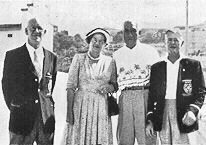 |
Forbes
(1958) includes a photograph of Duke in boardshorts with the
board, below, and reports ...
"He
called
in at our beach on the way back to Hawaii, and again
took out
his original board, 41 years after it had first been
used."
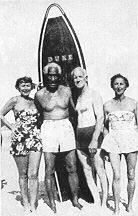
Duke
Kahanamoku, Claude West and their board.
Freshwater
Beach
1956.
Forbes
in Myers (1983) Page 18.
|
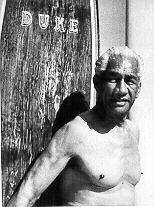
Duke
Kahanamoku and his 1914 board .
Freshwater
Beach
1956.
Carroll
(1991) Page 29.
Peter
Luck Productions
|
Kahanamoku was
accompanied members of the visiting American teams with their
Malibu boards.
Colour film of
the occassion, commissioned by sponsors Qantas and Ampol
Australia, shows Duke and the visitors in conversation on the
beach, all accompanied by their surfboards.
Tom Schroder
attempts to lift Duke's board but, struggling with it's weight,
hands it back to Kahanamoku and the five Malibu riders enter the
surf.
The film then
cuts to a squence of Tom Zahn and Greg Noll, apparently shot at
Bondi beach, see below.
Apart from Tom
Schroder, who is identified by the narrator, I am unable to
identify the other four riders.
Of the five
Malibu boards, three appear to be fibreglassed balsawood.
Tom Schroder's
board is fully coloured in orange, either resin or paint.
The other board
has two widely spaced timber stringers in a very light toned
blank, possibly bleached balsawood.
This board
conforms with the description "reinforced with two long
strips of redwood" , reported in the SMH
Wednesday 21 November, 1956. Page 15. See above.
The footage is
probably from the 1957 documentary, Service in the
Sun.
Thoms (2000)
Pages 63 -64.
The footage is
reproduced in Nat Young's A History of Australian Surfing
(1985) and also includes two short sequences that feature a
circa1984 interview with Tom Zahn.
TEXT>???
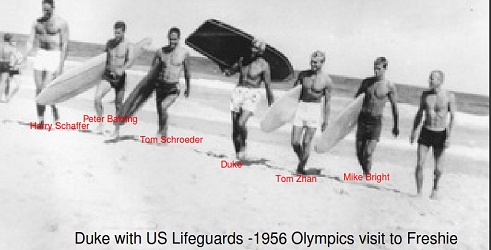
|
Duke returns from
the water with members of the USA Surf Life Saving
Team, Freshwater, 1956.
-photograph courtesy of Eric
Middledorp, Freswater LifeSaving Club, September, 2013.
|
In correspondence with
Eric Middldorp, Freshwater SLSC member Don Henderson
recalls the members of the American and Hawaiian Teams
visit to Freshwater Beach November 1956 were:Dan De Rego, Lew Hanka, Ralph Kanoho,
Tom Moore, Henry Kanoho, Reginald Fellaze,, Don Gustuson,
Harry Schaffer (Delegate)."
Peter Balding, Unknown, Tom
Schoeder, Nadine Kahanamoku, Duke Kahanamoku, Tom Zahn, Mike Bright
|
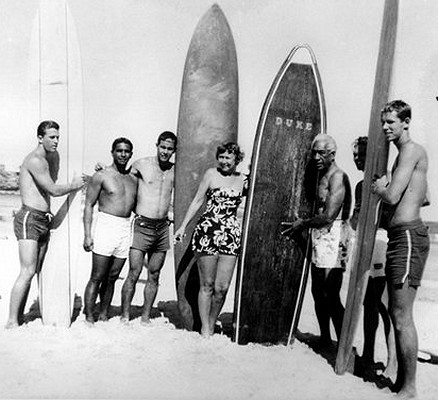
|
Balmoral Beach Club - ? December 1956.
Possibly
in the same week as the visit to Freshwater, Duke
Kahanamoku visited the Balmoral Beach Club, probably
to renew friendships with Clem and Lou Morath, forged
at the 1939-1940 Pan-Pacific Games in Honolulu.
Image
right :
"Duke Kahanamoku, Olympian and
pioneer surf board rider,
at
the (Balmoral Beach) Club in
1956,
with Anthony Bradhurst (left)
and Ian Macnaughtan."
Franki:
Balmoral
Beach
Club (1989) Page 41.
|
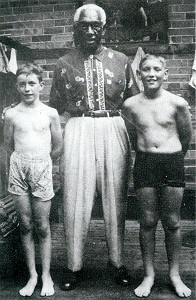
|
Bondi Beach - ? December 1956.
The
American-Hawaiian surfers made an appearance at Bondi Beach.
Three and half
minutes of the team surfing, was recorded on film and included
in the 1957 documentary, Service in the Sun.
Thoms (2000)
Pages 63 -64.
To Come :
Zahn and Noll Others?
Detailed
account of riders performance - wave count lefts/rights
turns and trims.short colours
Unfortunately,
the History of the Bondi Surf Bathers Life Saving Club
1906-1956, has no information subsequent to February
1956 and therefore no details of the December visit of U.S.A.
and Hawaiian surfers.
Manly Beach - ? December 1956.
Departure - ? December 1956.
Competitive Results - An Overview.
Considering the unfamiliar surfing
conditions and the alien contest structure, the competitive
results of the visitng American and Hawaiian surfers appear to
indicate a strong, if not dominant, performance.
Apart from the outstanding results of
Cronulla's Brian Keane in the two Sydney internationals, the
visitors dominated the board paddling events.
Their ability was recognised from
their fist appearance at Cronulla.
"The visiting American
surf team yesterday showed it could prove a major
threat to Australia's
domination of international surfing."
Sunday Telegraph
Sunday 18 November Page 76.
The results at Avalon the next day
appear to be largely overshadowed by the performance of the Malibu
riders and the successful rescue with a Torpedo buoy by Tad
Devine.
SMH 19th
November, 1956. Page 3.
At the first international contest at
Torquay, Tom Zahn won the board paddle, second was Mike Bright.
The Hawaiian team won the Beach Relay
and came third overall.
The results of the Australian
championships at Torquay the following weekend are unclear.
At the second international carnival,
held in large surf at Maroubra, Brian Keane from Cronulla won the
Board race, Tad Devine second and Greg Noll third.
Devine also placed first in the Belt
race and the Surf sace, an excellent performance given he was
probably unfamiliar with the equipment and the contest format..
The Beach Relay was won by
Hawaii, second U.S.A.and L. Hangca (Honka?) (Hawaii) won the
International Beach Sprint.
Sun Herald
Sunday 9th December, 1956. Page 42.
The following day at Collaroy, Keane
again won the board race, from Tom Zahn and Mike Brlght.
Tad Devine won the belt race "after
tripping
in the run down the beach to the water".
Tom Schroeder's win in the ski race, on
unfamiliar craft, was impressive and L Hanagca performed
well in the beach sprint, placing second in front of C. Mcllroy
(U.S.A.), third.
In the Marathon surf, a fore-runner of
the modern multi-discipline Ironman event, Tom Moore placed third.
SMH Monday
10th December, 1956. Page 11.
The results indicate that the
U.S.A. and Hawaiian competitors performed well over a range of
formats, venues, craft and conditions.
Whether these results caused
Australian officials any concern of a possible threat to their
dominace of the fledging world movement is unclear.
It appears the performance of the
American teams, like their advanced equipment and methods, were
politely ignored, exemplifed by Brawley's account of SLSAA
adminstrators' refusal to empirically assess the merits of the
Torpedo buoy, after the Collary carnival, see above.
Post Carnival Exposure
The impact of
the U.S.A. and Hawaiian surfers and their boards was further
enhanced when film of the team surfing Collaroy was shown as
cinema newsreel footage - Movietone News 28/3 (1957).
This was
followed by a colour film Service in the Sun
(1957), commissioned by sponsors Qantas and Ampol Australia,
including three and half minutes of the team surfing Malibu
boards at Bondi.
Thoms (2000)
Pages 63 -64.
After cinema
release, the footage was shown independently in virtually
every Surf Life Saving Club on the Australian coast. Some
of this, including the colour footage from Bondi, appears in Nat
Young’s The History of Australian Surfing film/video.
"The
films and our boards became the basis for the modern
surfboard movement in Australia."
Greg Noll also
filmed Australian surf, sequences were later included in films
shown in America...
"I
had bought a Bell and Howell movie camera from (snow
ski film producer) Warren Miller.
... I
thought it would be fun to show everybody back home what
Australian surf looked like."
These images may
have encouraged other American surfers to consider the
attractions of Australian surf.
Bruce Brown,
accompanied by Phil Edwards, travelled the east coast in 1961,
shooting sequences at Fairy Bower and Byron Bay, included in his
1962 release, Surfing Hollow Days.
In 1966, Brown
would produce the benchmark in surfing films, The Endless
Summer, reprised thirty years later with The
Endless Summer II.
Phil Edwards was
voted the best surfer in the world in a 1964 poll conducted by Surfing
magazine.
Australian Surfboards - Post 1956.
In 1956
the lack of balsa would be side stepped by immediately
adapting Tom Blakes' now well proven Hollow board to
Malibu dimensions with a large fin - known as the Okinuee.
This
design was manufactured by the noted 16 footer builders
- Gordon Woods, Bill Wallace, Norm Casey and Barry
Bennett.
The
enthusiasm for the new design was such that Gordon
Woods had built and tested his first Okinuee before
the US team departed.
Gordon Woods, Phone
conversation, 18 th July 2005.
By the
end of 1956 Scott Dillon had ordered an Okinuee, a
finned hollow timber board, from Gordon Woods.
- Scott Dillon Interview
29th June 2005. Coffs Harbour NSW.
Image
right :
Gordon
Woods' Velzy-Jacobs fibreglassed balsawood
Malibu
surfboard, purchased from Bob
Burnside
(right) and his first plywood copy.
Nat History (1983)
page 90.
Photograph
: Gordon Woods.
|
|
The first
Australian manufactured balsa/fibreglass boards (three only)
were by Roger 'Duck' Keiran soon after the Olympic Carnivals,
but a lack of balsa wood supply meant that the design was not
available for general use.
By 1958, Australian
boardriders were using a variety of craft.
Consider the image, left.
"Hot Doggers' of
the Surf"
Malibus and Pigs, Bondi
1958.
Source : Unknown, probably
newspaper cutting.
From the right, the first
board with the shield decor and script "B.R." is
probably a hollow Okinuee Malibu template.
The next three are wide tail
Pigs, the design credited to Dale Velsey of California.
The second Pig , at centre,
is probably a fibreglassed balsa board and the script
decor, the rider's name.
|
|
The third Pig is held by famous
Bondi surfer, Jack "Bluey" Mayes and is marked with an "M".
It is probably an early polystyrene
board built for Mayes by Scott Dillon and Noel Ward in
Wellington Lane, Bondi, circa 1958.
The final Malibu board, decorated with the initials "S D" , is of particular
interest.
The rider is noted big-wave sufer and
an early surfboard maufacturerer, Scott Dillon
It is
fibreglassed with two widely spaced timber stringers in a
very light toned blank, possibly bleached balsawood.
This board
closely resembles one of the six boards filmed at Freshwater
Beach in November 1956, noted above.
Historians of surfing culture may
note the riders are wearing long legged shorts, certainly a
radical change from all previous Australian beach wear.
A colour version of the above
newspaper/magazine photograph was later reproduced in Barnett: Australian Sport
(2005), page 309, accredited to Private collection.
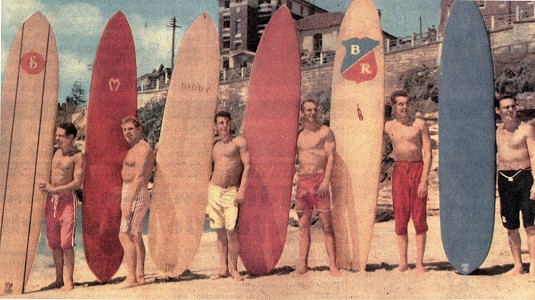
Surfboards in New Zealand and South Africa - Post
1956.
With a
traditional relationship with the Australian movement, a more
primitive manufacturing base and limited access to materials,
New Zealand and South Africa initially adopted the Okinuee - the
hollow timber adaptation of the malibu design by Australian
manufacturers.
In New Zealand
the design specifications were quickly absorbed, but the
development of a locally produced fibreglass board was still
some years away.
The Levine
was a brand name for New Zealand hollow timber board marketed
as a do-it-yourself pre-cut kit, circa1958.
Based on the
Malibu board it featured a wide square tail, narrow rounded
nose and a standard D fin set right at the pod.
Most
interesting is the full vee bottom from nose to tail.
Common factory
length appears to be 9 ft 1 inch.
Phone conversation with Tony Reid, New
Zealand, circa 1999.
.In New
Zealand the design specifications were quickly absorbed,
but the development of a locally produced fibreglass
board was still some years away.
The
Levine was a brand name for New Zealand hollow
timber board marketed as a do-it-yourself pre-cut kit,
circa1958.
Based on
the Malibu board it featured a wide square tail, narrow
rounded nose and a standard D fin set right at the pod.
Most
interesting is the full vee bottom from nose to tail.
Common
factory length appears to be 9 ft 1 inch.Phone
conversation with Tony Reid, New Zealand, circa 1999.
Image
right :
"Peter
Miller with his 1957 Malibu inspired longboard,
named 'Enid'.
Photograph
Peter
Miller."
Luke
Williamson notes ..."In 1957, in Hamilton (New
Zealand), Peter Miller made a longboard based on a
design published in 'Australian Outdoors Magazine'
and it was probably the most up-to-date surfboard in
the country at the time.
Peter
Miller: 'I built a a 10' longboard, 24" wide by 4"
deep out of a
'I
built a 10' longboard, 24" wide by 4" deep, out of a
hollow white pine frame screwed to redwood nose and
tail blocks. This was covered with thin marine ply.
The rails were rounded, shaped redwood, and the fin
was wood; 12" deep, shaped and fibre glassed to the
board. I remember turning up at the Mount Maunganui
Surf Life Saving Club with it when I had finished.
No one had seen such a short board, and had never
seen rounded rails or a fin. "That fin won't last
the day, " shouted the club members. The board was
hard to stand up on so I glued beading along the
rails to stop myself from slipping off when standing
-no one had told us about using wax.''
|
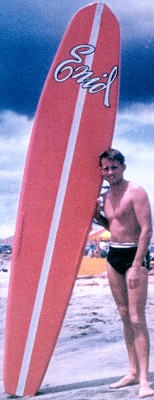
|
Australian
Outdoors
November,
1957,
Renwick, Ross: Build yourself an okinuee board.
pages 16
to 21 .
See
Source Documents
Ross Renwick : Build
yourself
an Okinuee Board.
|
|
The Okinuee also appeared in South
Africa.
Reginald
C. Blunt, purchased an Okinuee board from Australia,
probably manufactured by one of the early Sydney
builders, circa 1958-1959.
Image
right:
"Plate
30. Reginald C. Blunt with new Australian board
at
Durban, South Africa.
By
Scotty, South Beach, Durban, South Africa."
Patterson
(1960) Plate 30. |
 |
A further
alternative of using polystyrene foam, commercially available
for insulation, was adapted by Greg McDonagh at Freswater and
Scott Dillon with Noel Ward at Bondi, probably around1958.
It is possible
that by this time some builders may have seen or heard of Bill
Reid's "Fun on
a Plastic Surfboard" article from 1953 that
uses a styrofoam blank.
The tour
initiated correspondence on construction and design between
American and Australian manufacturers,
that
accelerated with the introduction of polyester foam blanks.
"For
about two years after that trip I got letters every week
from guys in Australia, pleading
for
pictures, templates, design information. It was a new
frontier for them.
By then I
was making boards, but it was too expensive to ship them
down there.
I stayed
in contact with one guy (unidentified) for
a while, sent him templates.
Took
pictures of boards from the top, bottom, sideways, rear."
CONCLUSIONS
The equipment, methods and skills of
U.S.A. and Hawaiian competitors demonstrated at a series of
lifesaving carnivals Australia in November-December 1956,
radically changed Australian surf riding culture.
Upon arrival, the Americans
enthusiastically promoted their new designs in the press;
however the impact of the boards in action was dramatic and the
exposure had long term repercussions.
The impact was probably first in
evidence at Avalon Beach on the afternoon of Sunday 18th
November, 1956.
Demand for the new board design was
tempered by a limited supply of balsawood and unfamiliararity
with fibreglass technology, but Australian board builders
replicated the design in the well established hollow plywood
construction.
With improved access to materials,
surfboard manufacture swiftly moved from a backyard or surf club
activity to an industial factory location, initially centred in
Brookvale, Sydney.
While boardriders were enthusiastic,
Australian surf life saving officials largely ignored American
equipment and methods.
In the short term, some surf life
saving clubs actively discouraged the use of the Malibu board
and viewed it's popularity as a threat to their dominant beach
presence.
In the long term, fibreglass
technology would dominate surfcraft construction and however,
the Torpedo buoy would eventually replace the belt and reel.
REFERENCES
The International
Surf Carnivals, Australia, 1956.
Australian
Newspaper Extracts from Sydney Morning Herald, Daily
Telegraph, The Sun and The Age.
In May 2008, Ian
Nicol forwarded the following:
"a couple of the old guys
still surviving at Dee Why SLSC went to the surf
carnival associated with the 1956 Melbourne Olympics
and apparently that trip was when a lot of Aus surfers
first saw US malibu boards and quickly started to copy
them."
Natalie
Wood, Waikiki, 1956.
|

|

surfresearch.com.au
links
Malcom Gault-Williams: LEGENDARY SURFERS Homepage
SYDNEY, Tuesday: Police believe a jealous woman may have murdered Colin Bruce Sparks,
26-year-old
Australian surf champion,
whose bullet-riddled body was found in a car in Marine drive/ Tamarama
Beach,
near
Bondi this morning.
Police
have been told the 6ft. fall, husky Sparks was a "fickle and reckless lover-out with a different girl every night."
? A
woman's handbag was found in the murder 'car, but police do not necessarily connect it with the . killer.
Sparks
had one con
viction, for indecent
assault.
Police
were told a man was seen
running from Sparks' car
after local residents heard
shots about 7l30 a.m.
But
they believe the man who was
seen running had left
another car parked on Marine
drive.
|
Sparks' body was noticed I by Gordon Marshall, of
Thompson st., Tamarama, about
half an hour after the
residents heard the shots.
It was
lying on the front
seat of
his parked car with
two
9mm. bullets in the left : arm, a third into the shoul- , der, and a fourth in the chest.
Detectives found four shells
from the bullets on the floor
of the car.
Police
are not sure whether the
shots were fired from the front or back seats.
Champion
Sparks, a coal trimmer
employed by the Sydney Steam
Colliery Stevedore's
Association, was a member of North Bondi Surf
Life Saving
Club and with three
other
lifesavers, won last 1 year's
Australian surf teams' ^ championship. ^
He had
been selected with ' three
.others to represent , N.S.W.
at the international ' surf' carnival
at Torquay,
Victoria, during the Olympic . Games. ,
A
bachelor, he lived with his
mother in a flat in Bondi rd., Bondi.
He told
his mother early ; last
night that he intended going
to a picture show.
Trove
1956 'Jealous lover hunt in surf star's murder.', The
Argus (Melbourne, Vic. : 1848 - 1957), 17 October, p. 5,
viewed 2 October, 2013, http://nla.gov.au/nla.news-article84391981



















